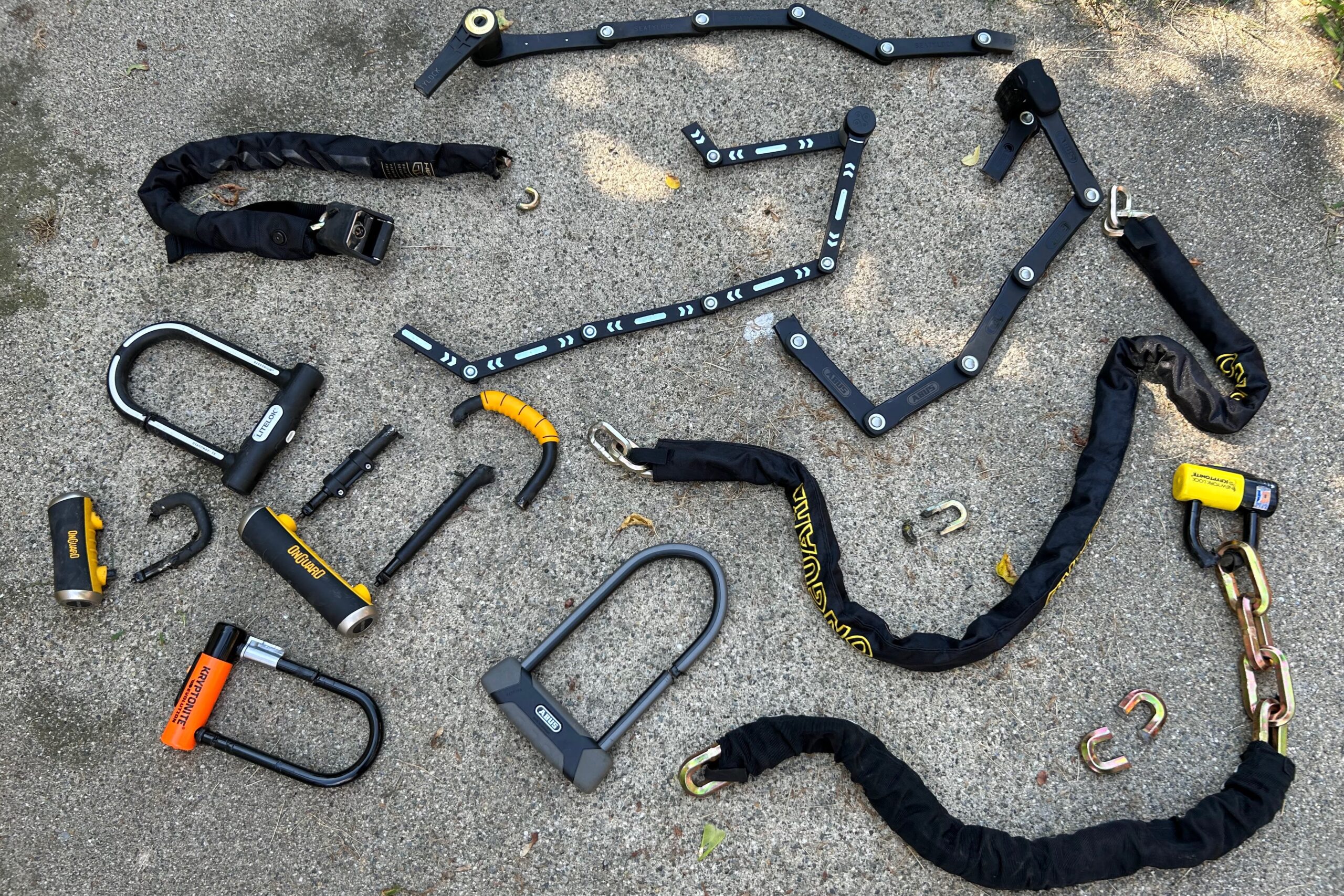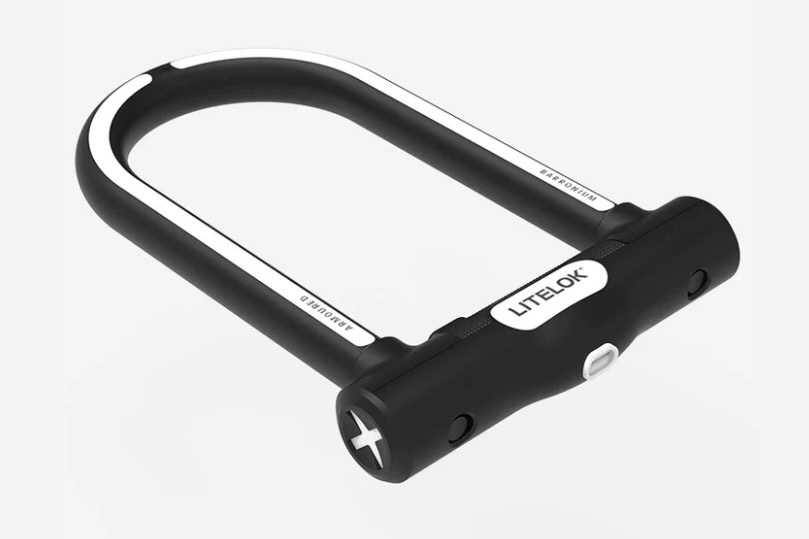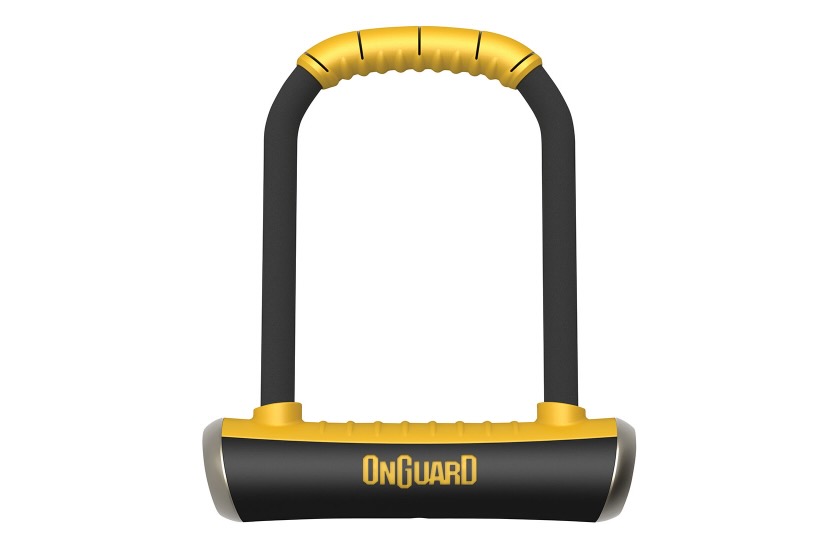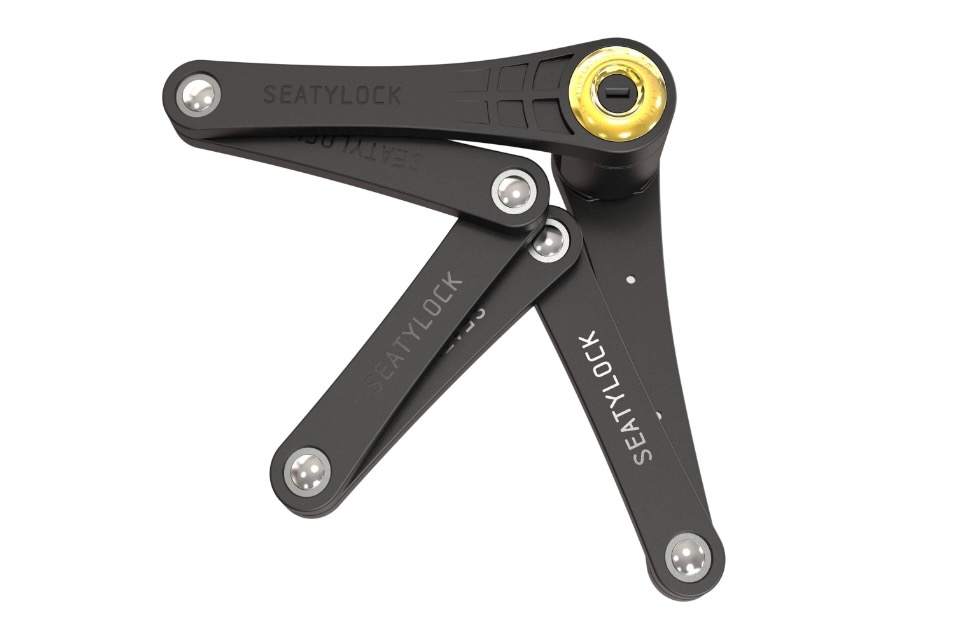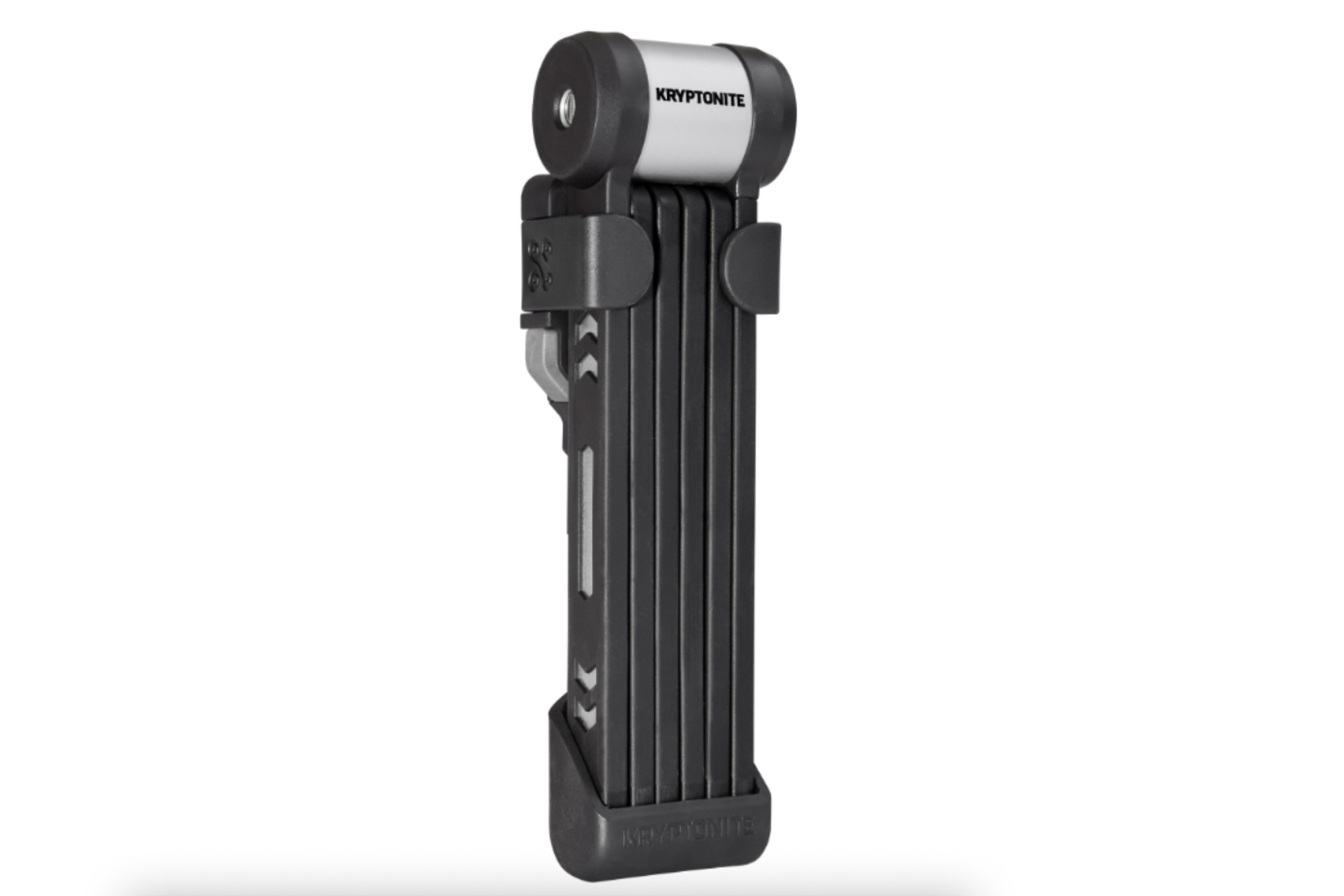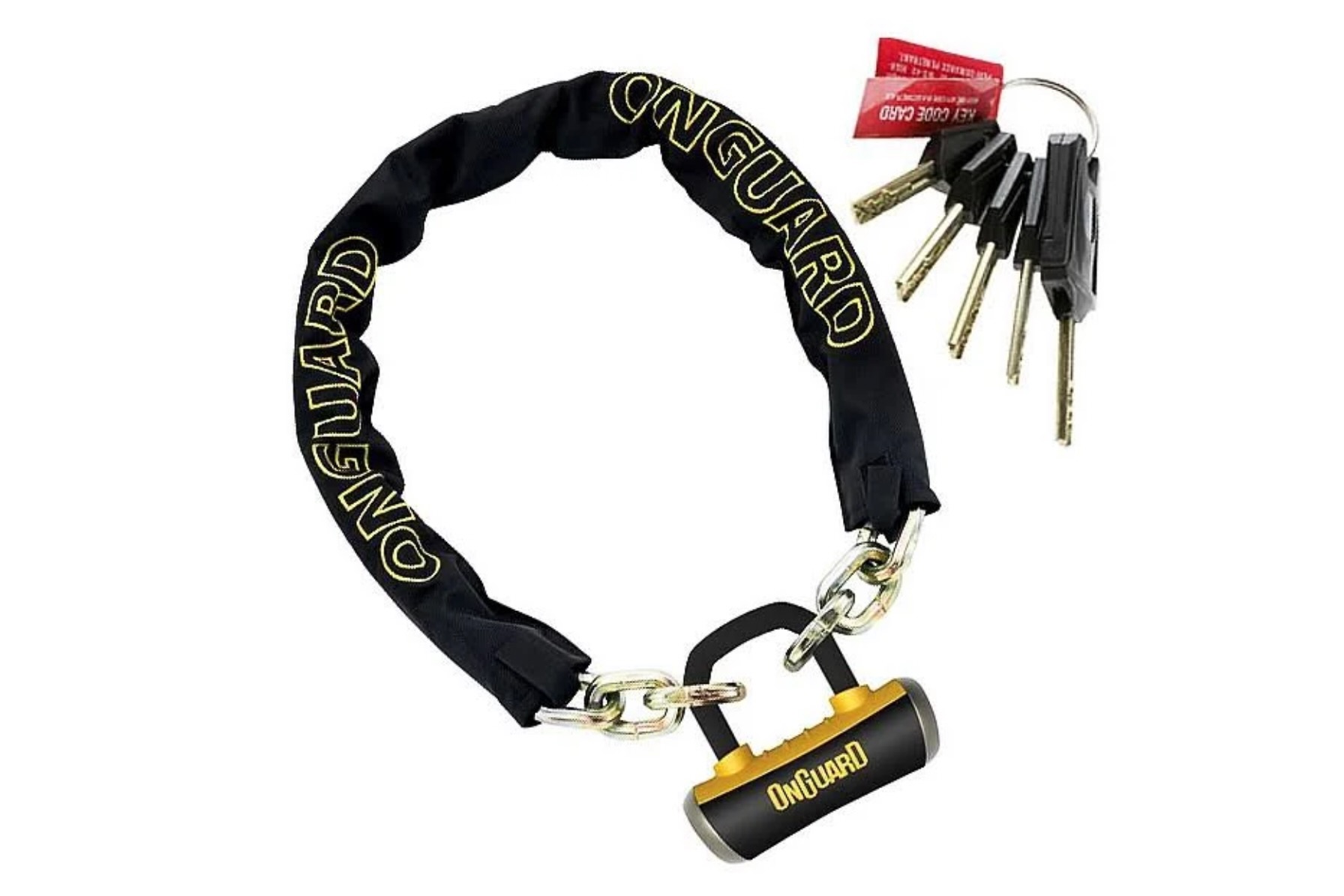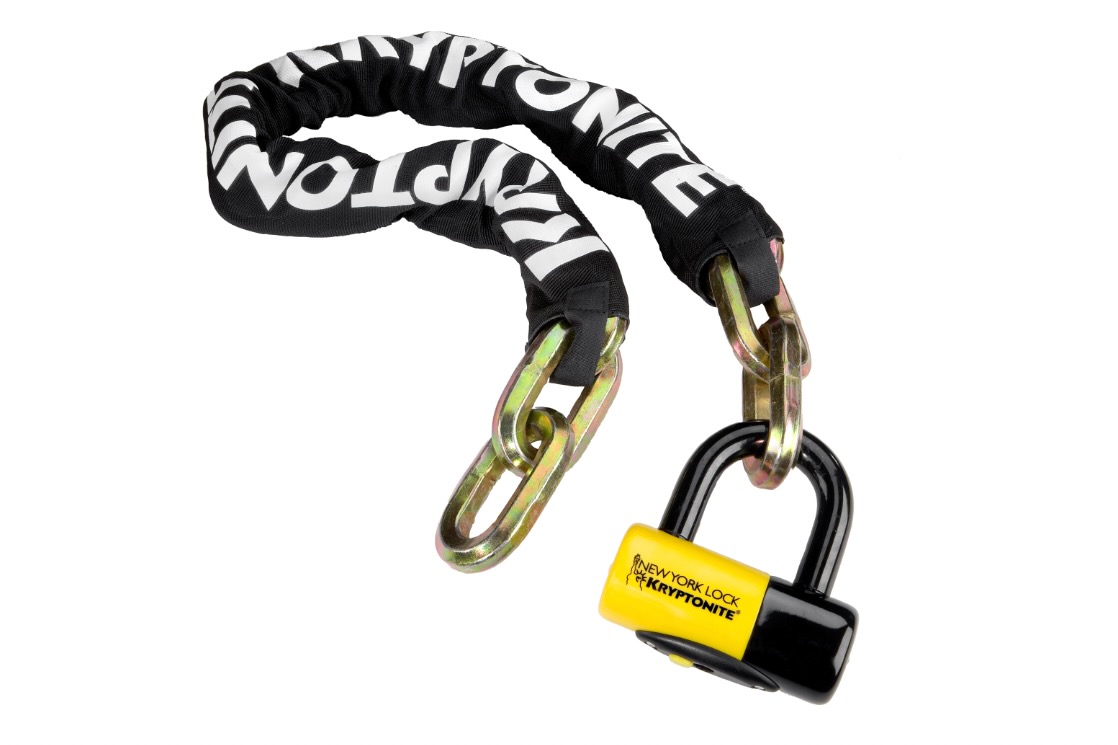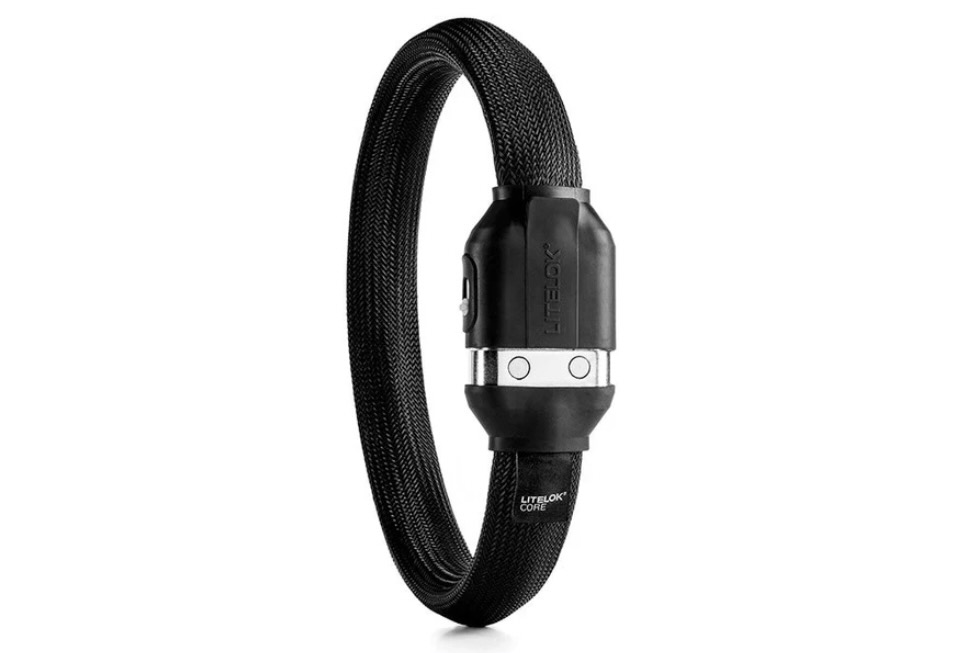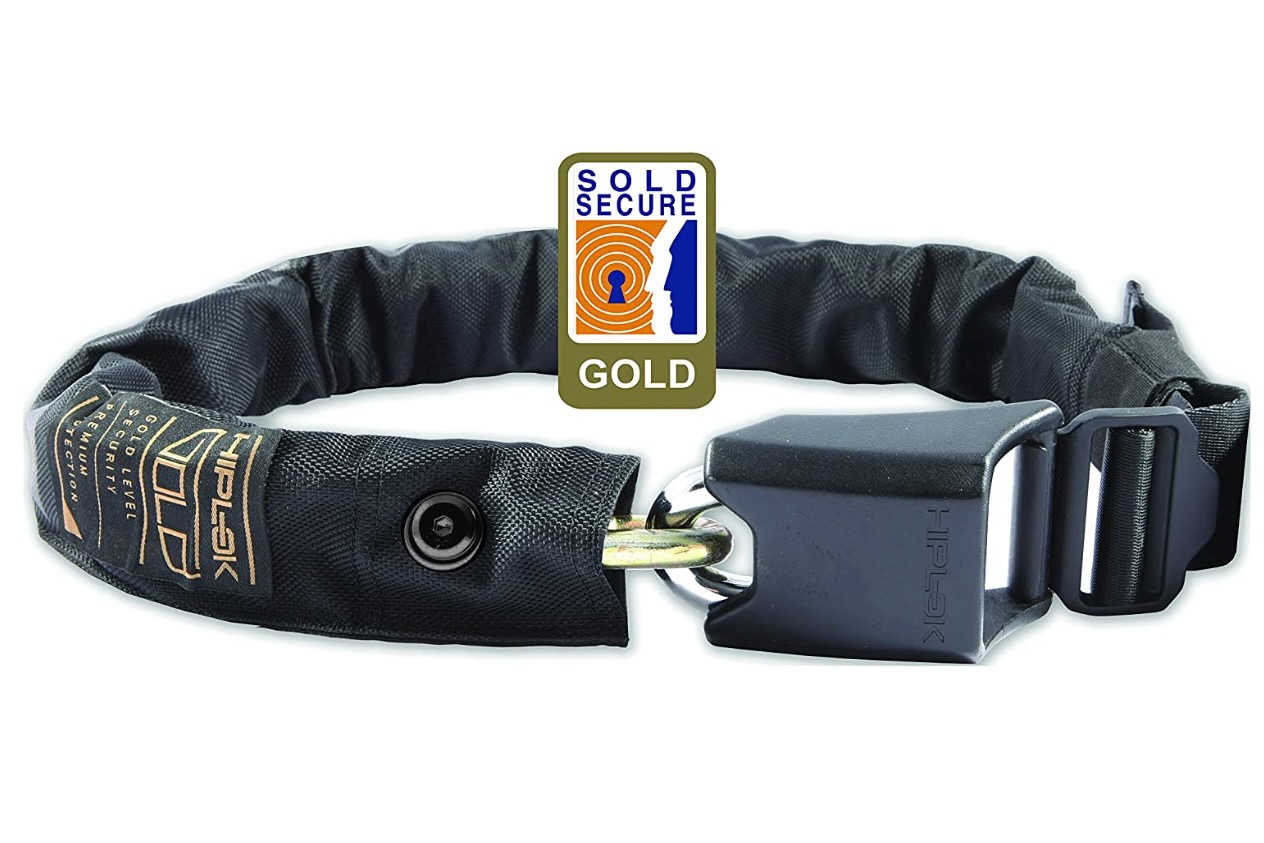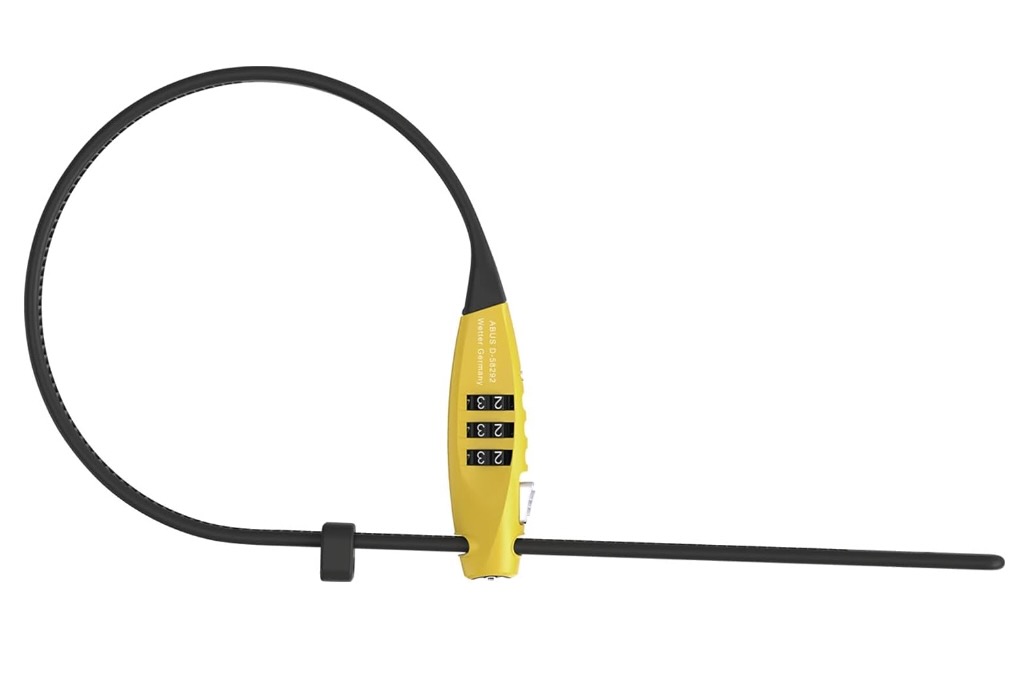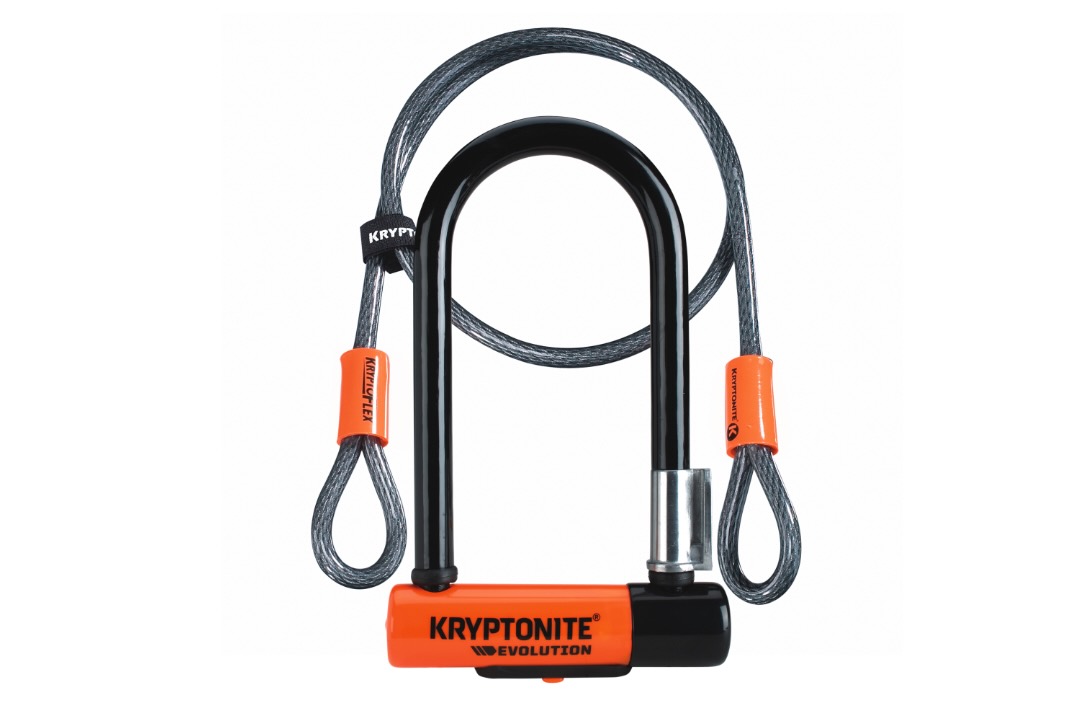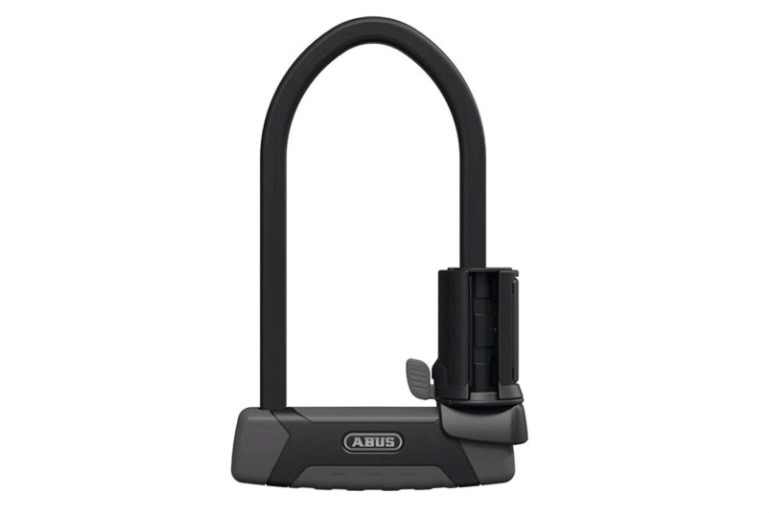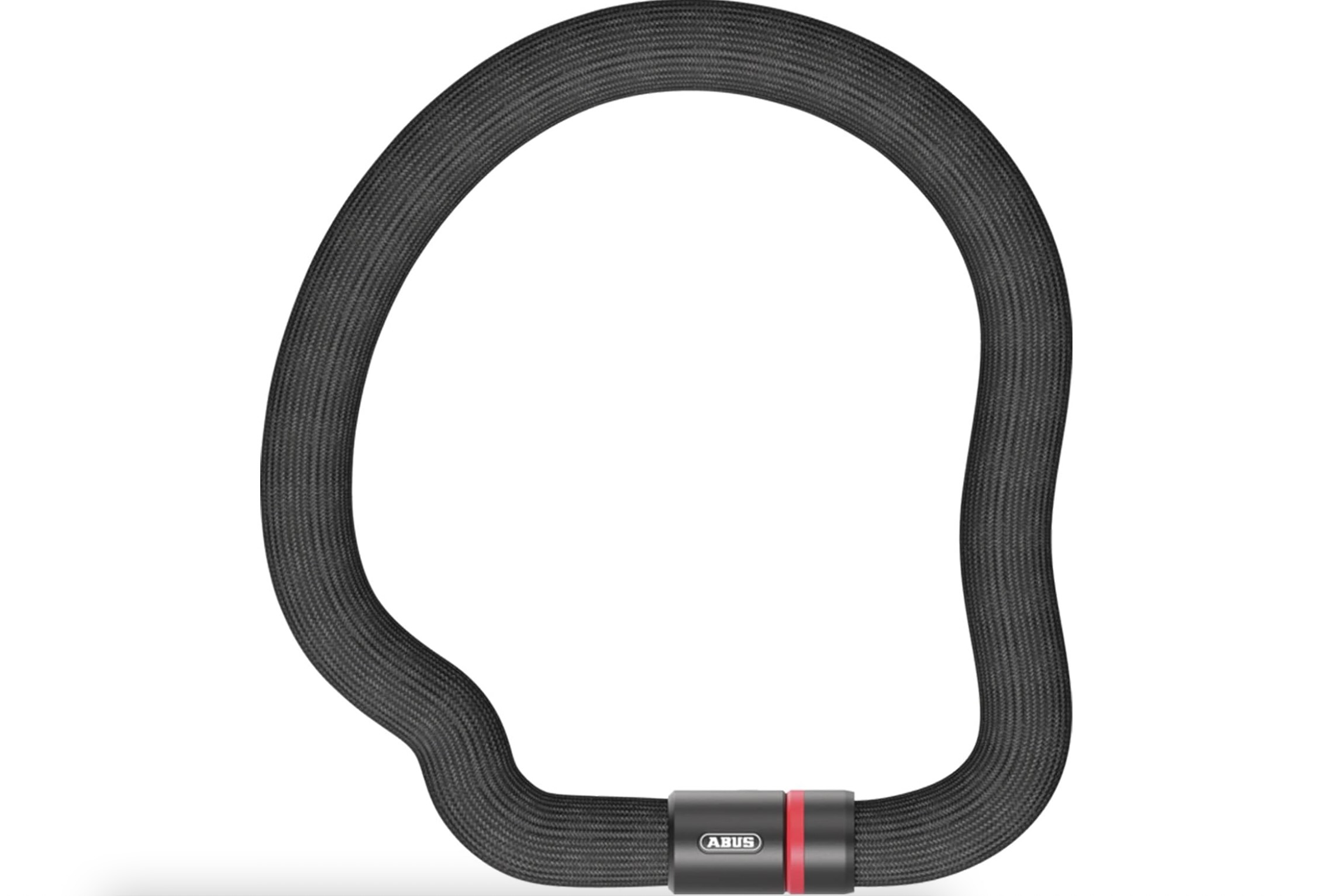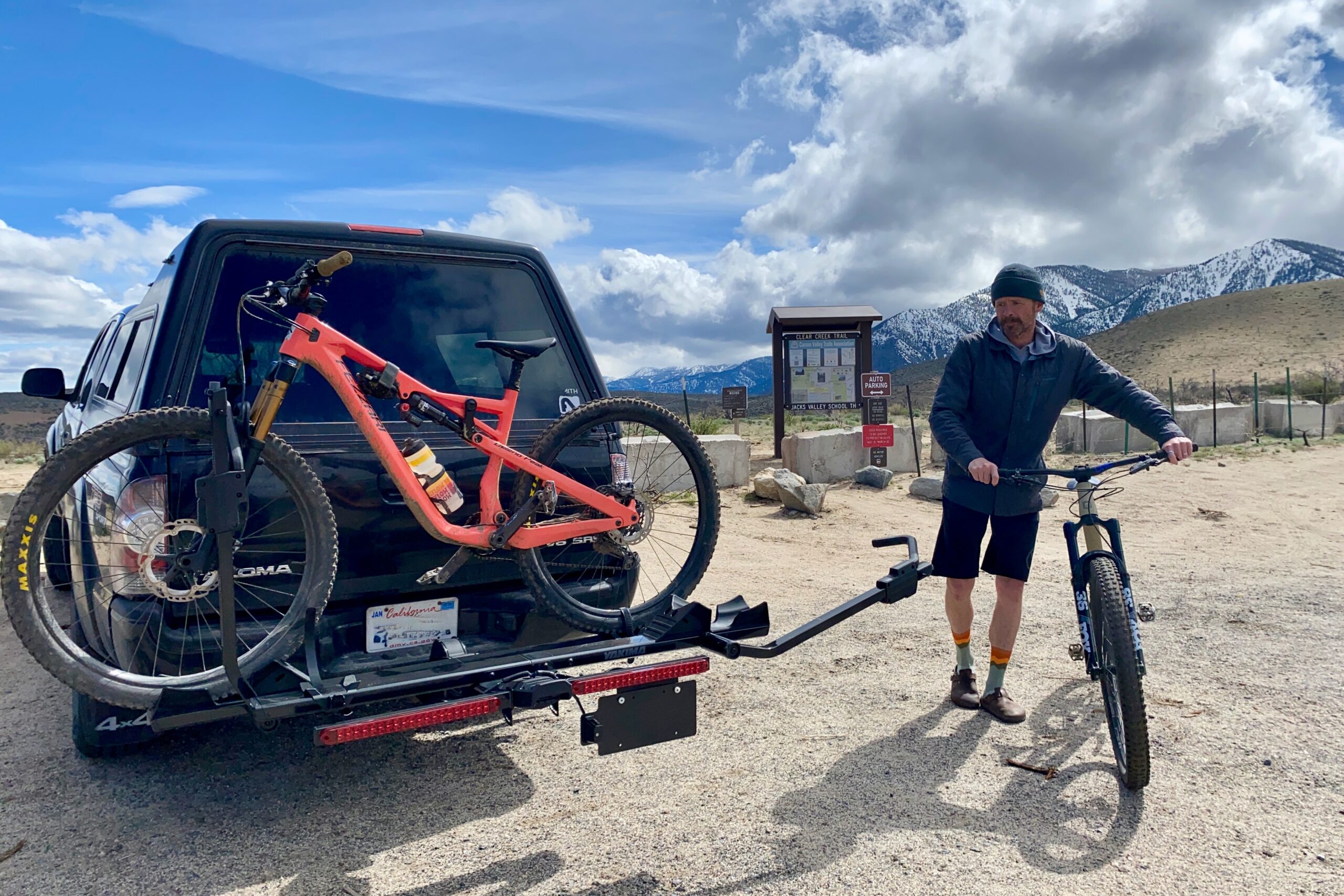If you own a bike of any sort, you need a quality bike lock. Bike theft is a common occurrence, and no matter what type of bike or where you ride, having a bicycle stolen is soul-crushing — and stolen bicycles are rarely recovered.
Whether you are a recreational road, gravel, or mountain biker, a commuter, or someone who relies solely on your bike for transportation, bike theft will negatively impact your life. And, with the price of bikes these days, this can potentially be a large budget consideration, no matter your means. Even worse, if you rely on your bike as your primary mode of transportation, the monetary loss could be compounded by missing work and paying for alternative transportation.
Bike thieves are often opportunistic and tenacious individuals who will happily steal your bike if given the chance. Locking your bike is a powerful deterrent that can greatly mitigate the risk of your ride being stolen. You should certainly use a bike lock whenever your bike is left unattended. But which bike lock is the best for you?
With so many locks available, choosing the right one can be a hard choice. To help, we tested 13 of the best bike locks available in 2025. We used each of these locks for weeks, locking our bikes to bike racks, benches, light poles, and hitch bike racks before subjecting them to a series of destructive tests to see for ourselves how easily they could be compromised. We’ve got recommendations based on the security, portability, and ease of use for U-locks, chains, and folding lock options based on the results of our testing.
Editor’s note: We updated our bike locks guide on November 17, 2025, with the addition of the LITELOK CORE Plus, our top recommendation for the most secure wearable bike lock.
The Best Bike Locks of 2025
Litelok X1
- MSRP: $200
- Type: U-Lock
- Sold Secure Rating: Diamond
- Mfg. Security Rating: Highest
- Materials: Barronium (angle grinder resistant) with hardened steel
- Weight: Lock: 1711 grams (3.8 lbs), Frame mount: 157 grams
- Dimensions: Locking area: 10.1cm x 19.6cm
Pros
- Diamond Sold Secure Rating
- Reflective finish
- Angle grinder resistant – destroyed over two wheels to compromise
- Easy to use frame mount with option to attach to water bottle braze-ons
- Automatically covered keyhole with use of rubber grommet
Cons
- Expensive
- Only two keys provided, no LED
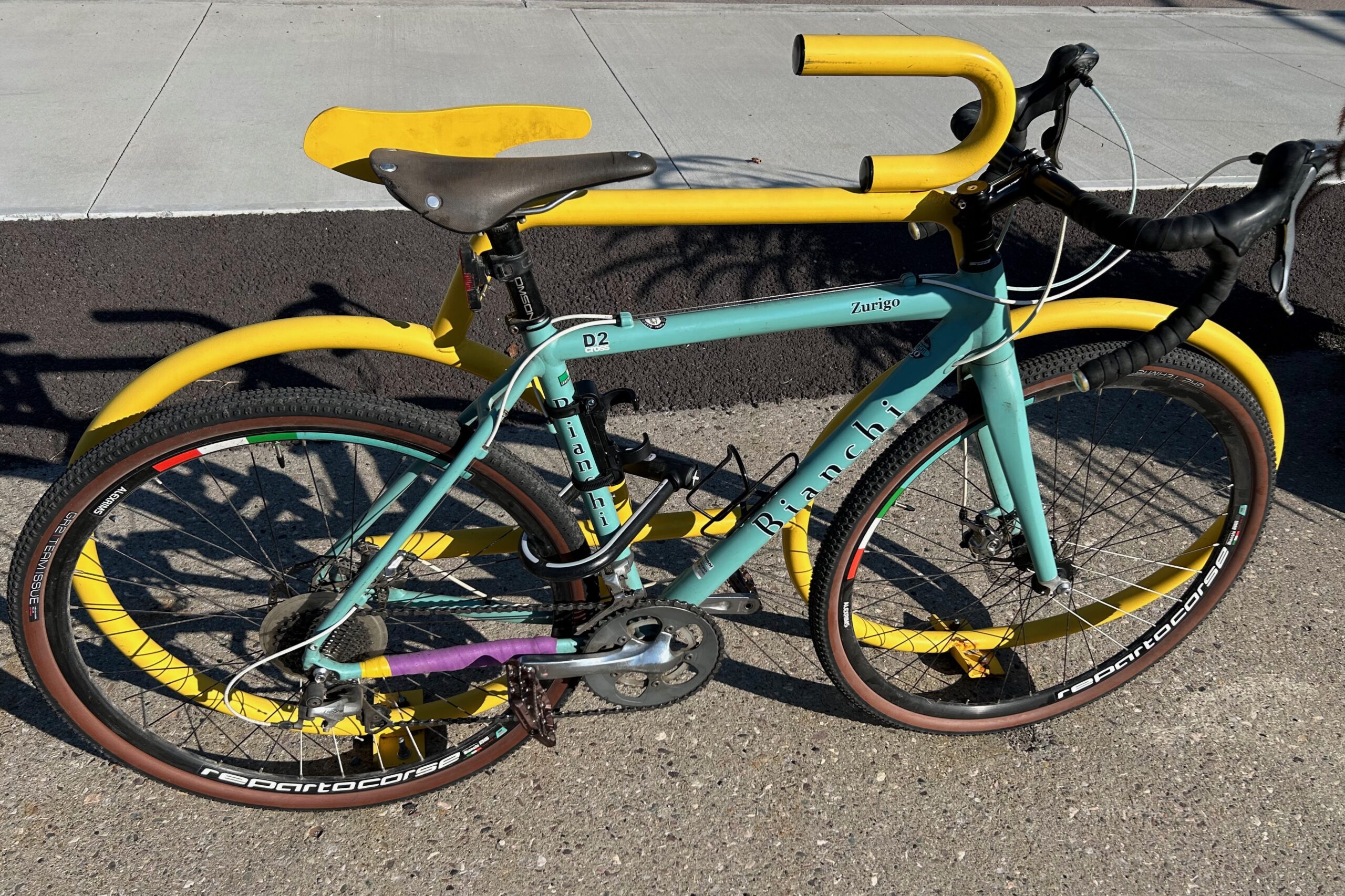
OnGuard Brute 8001 STD
- MSRP: $90
- Type: U-Lock
- Sold Secure Rating: Diamond
- Mfg. Security Rating: 95/100
- Materials: Hardened Steel
- Weight: Lock: 1643 grams (3.6 lbs), Frame mount: 78 grams
- Dimensions: 11.5cm x 20.2cm locking area
Pros
- Solid construction
- Good key feel
- Diamond Sold Secure ranking
- Great value
- Fairly large, square locking area for a U-lock
- $5001 Bicycle anti-theft offer
Cons
- Phillips head bolts on frame mount
- Frame mount doesn’t play nice with external cables
- $5001 Bicycle anti-theft offer NOT available in NY or outside the US
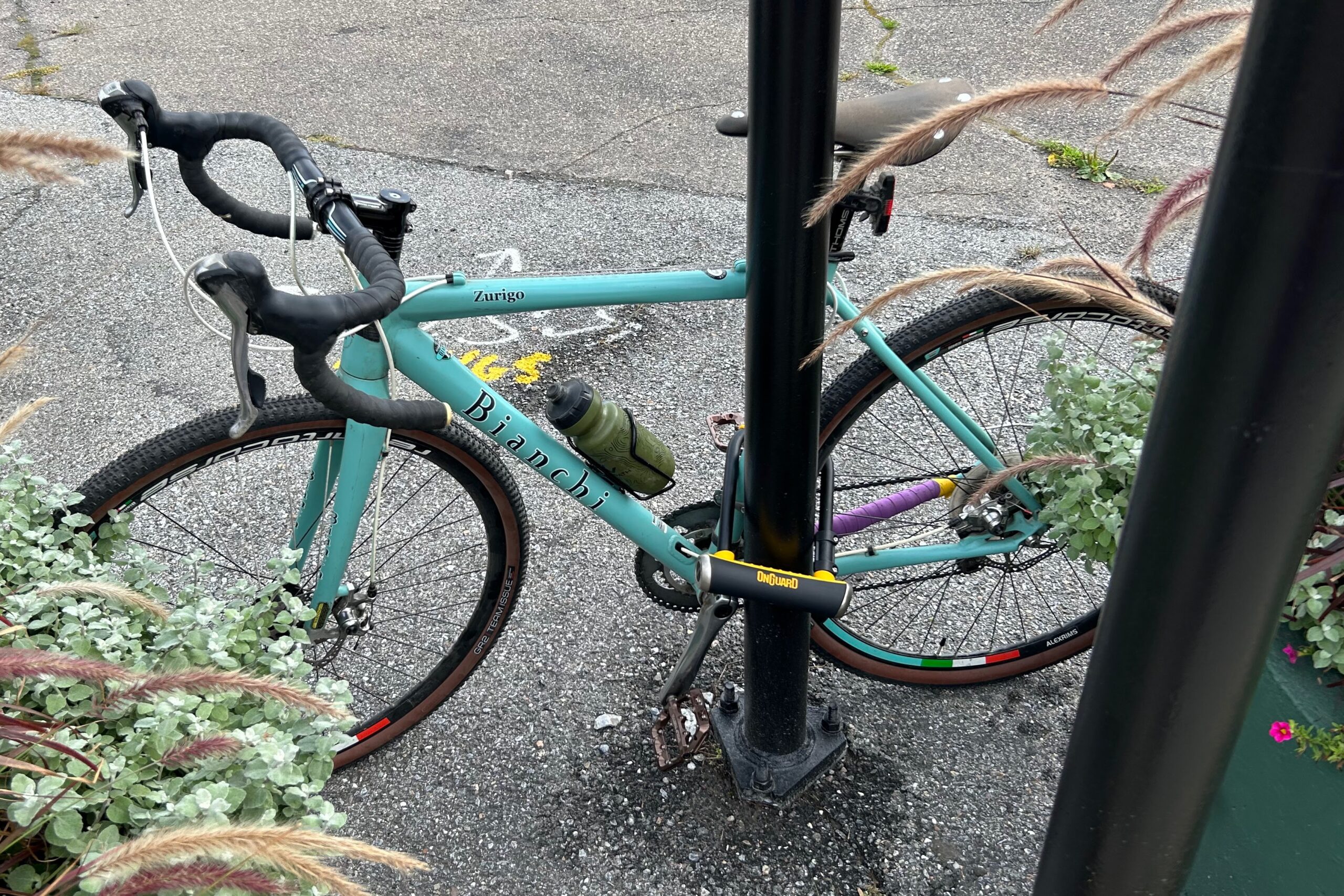
Seatylock Foldylock Forever
- MSRP: $135
- Type: Folding
- Sold Secure Rating: Gold
- Mfg. Security Rating: 18/18
- Materials: Rubber coated hardened steel bars
- Weight: Lock: 1632 grams (3.6 lbs), Frame mount: 149 grams
- Dimensions: 90 cm locking perimeter, 6.9 x 20.5 cm folded
Pros
- Smooth key action with defined open/closed positions
- Easy to use and carry
- Mounts to included frame bracket and is super quiet
- Very well-made
- Sold Secure Gold and ART-3 ratings = most secure folding lock on the market
Cons
- Can be cut with angle grinder
- Heavy-ish
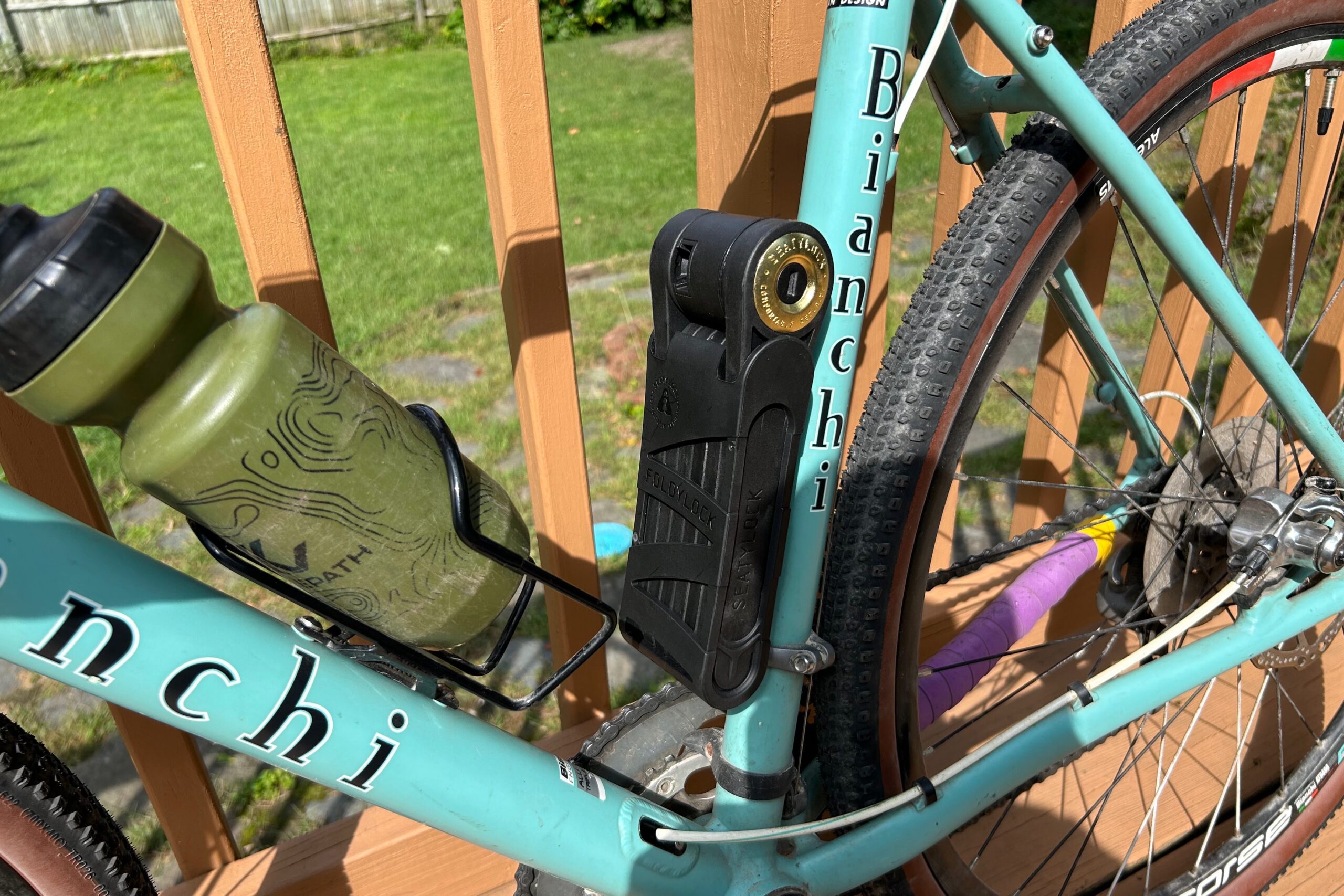
Kryptonite KryptoLok 610 S
- MSRP: $143
- Type: Folding
- Sold Secure Rating: Not rated (other Kryptonite folding locks are rated Bronze)
- Mfg. Security Rating: 6/10
- Materials: Hardened Steel
- Weight: Lock: 1160 grams (2.5 lbs), Frame mount: 182 grams
- Dimensions: 100cm locking perimeter
Pros
- Easy to mount to bike or carry in a bag
- Can be mounted to braze on water bottle mounts or on frame bracket
- Easy to use and route when locking the bike due to full locking head/slot rotation – no fighting to align the bar with the slot
- Good firm key feel
- Lightest folding lock
Cons
- Only two keys provided, no LED key
- Medium security
- Cheap, easily deformed plastic screws for frame bracket mount
- Not yet rated by Sold Secure
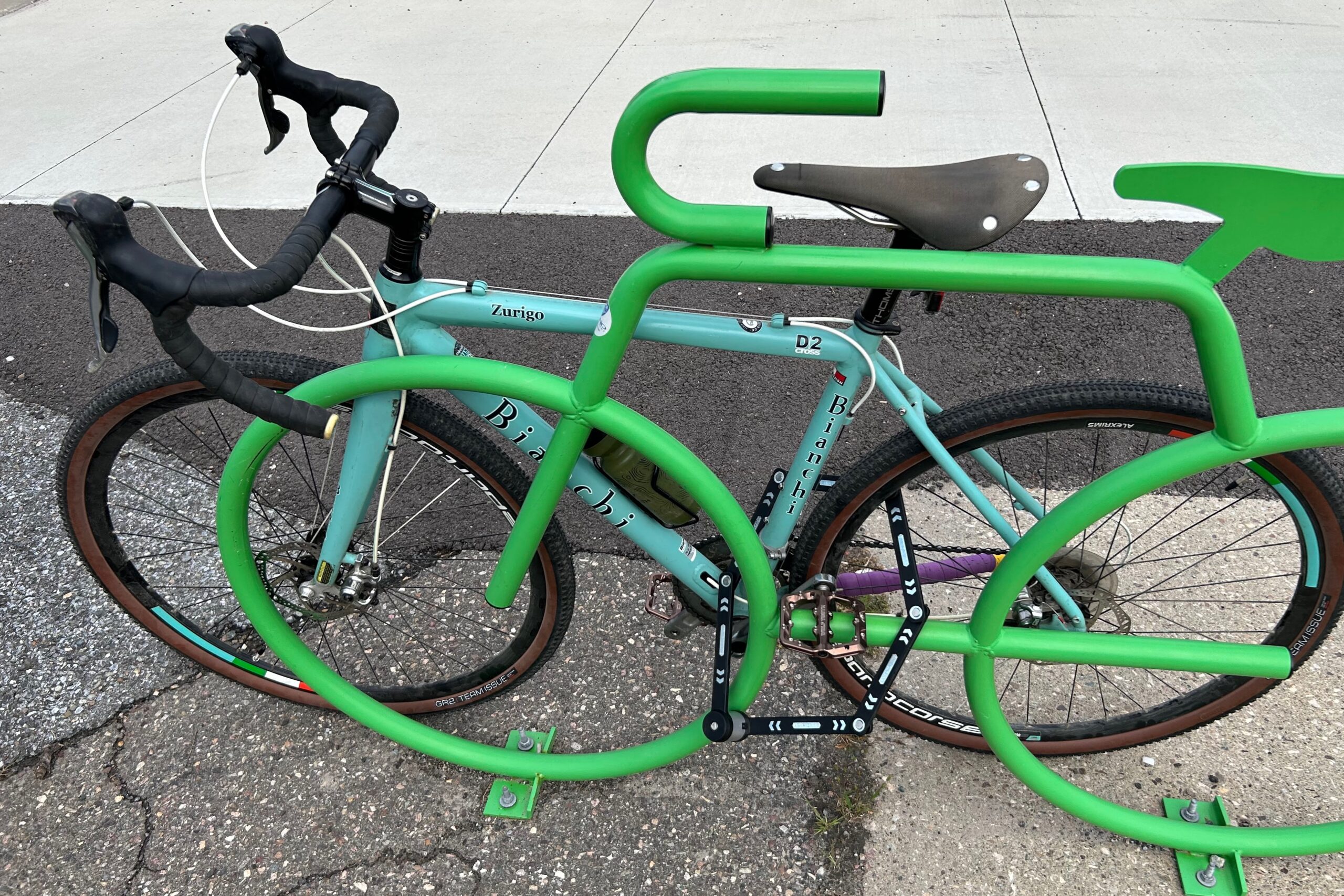
OnGuard Mastiff 8019L
- MSRP: $130
- Type: Chain
- Sold Secure Rating: Gold
- Mfg. Security Rating: 90/100
- Materials: Titanium reinforced steel with fabric chain cover
- Weight: 4876 grams (10.75 lbs)
- Dimensions: 180cm locking perimeter, 10mm chain link gauge, 14mm lock diameter
Pros
- Longest chain lock we tested
- Can lock two bikes on a hitch rack, including wheels and frame
- Webbing/fabric cover has velcro strips at each end to keep it from creeping along the chain
- $3001 Anti-theft offer for bicycles
Cons
- Very heavy
- Difficult to transport on person and bulky in a bag
- $3001 Anti-theft offer for bicycles NOT available in NY or outside of the US
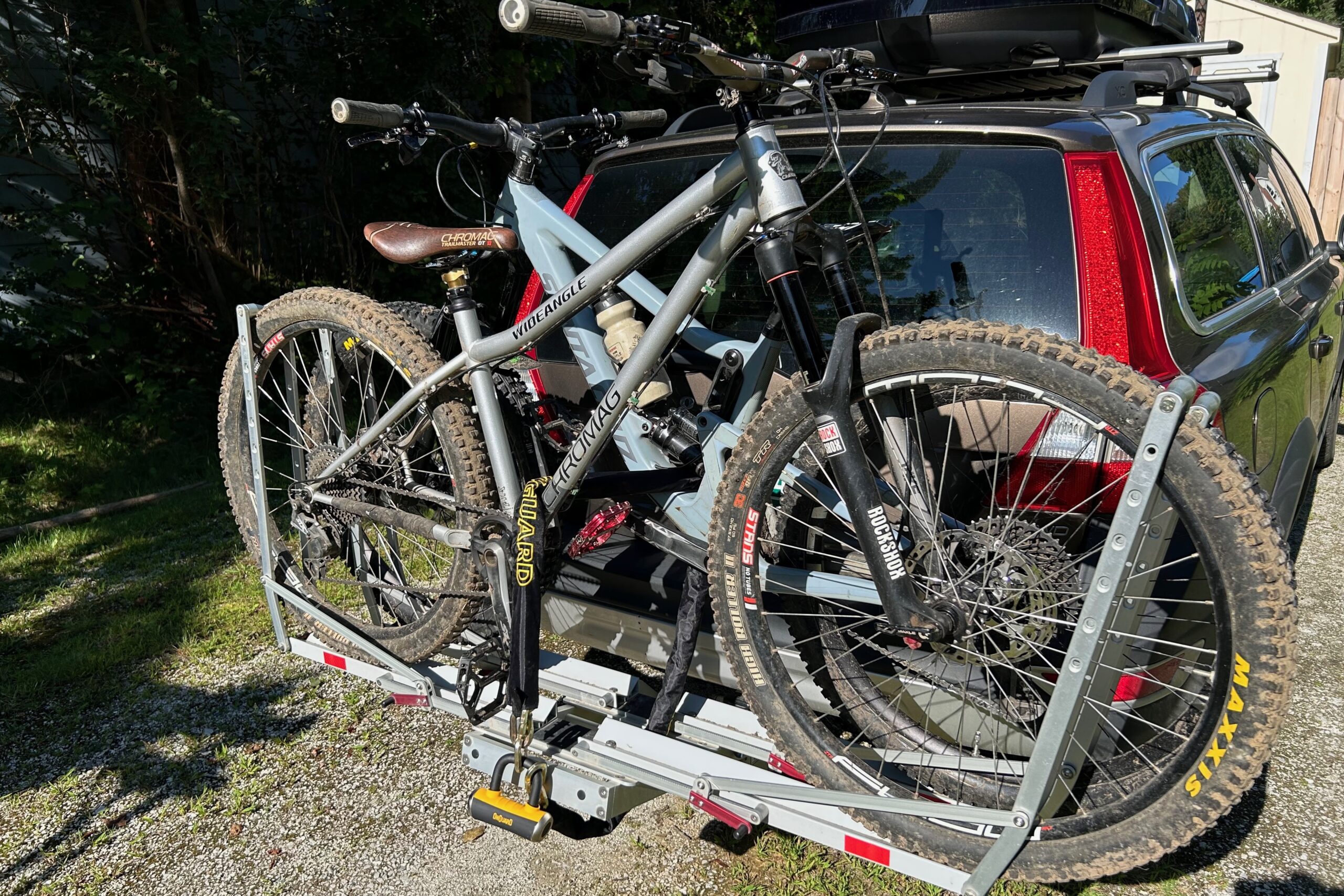
Kryptonite New York Fahgettaboudit Chain 1410
- MSRP: $179
- Type: Chain
- Sold Secure rating: Diamond
- Mfg. Security Rating: 10/10
- Materials: 3t Hardened Manganese Steel with fabric cover
- Weight: 5034 grams (11.1 lbs)
- Dimensions: 100cm locking perimeter, 14mm chain link gauge, 15mm shackle diameter
Pros
- Diamond sold secure rating
- Very secure
- Large size may help deter thieves
- Large size does not seem to limit routing through most frames
- $5000 Anti-Theft Protection Offer
Cons
- Very heavy – heaviest in test
- Difficult to transport
- 100cm length is limiting
- Mediocre key feel – a bit of slop
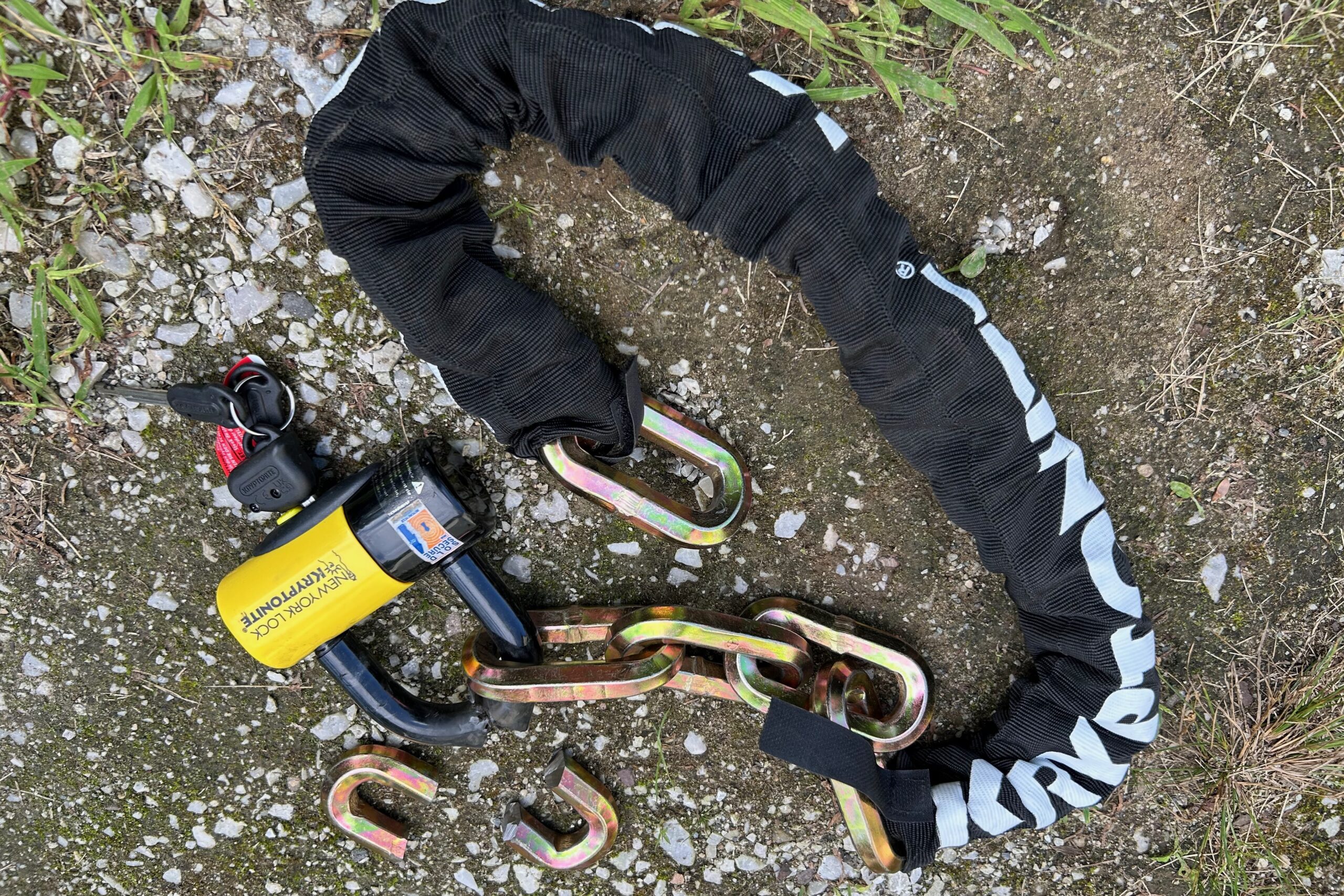
LITELOK CORE Plus
- MSRP: $180
- Type: Wearable, keyed
- Sold Secure Rating: Diamond
- Mfg. Security Rating: Highest
- Materials: Boaflexicore, steel exoskeleton, and polymer sheath
- Weight: Lock: grams (4.1 lbs.), Frame mount: 157 grams
- Dimensions: Locking area: 75 cm loop (100 cm also available)
Pros
- Wearable design
- Fairly comfortable on the waist
- Comes in two sizes
- Diamond Sold Secure rating is impressive for a wearable
- Larger locking area than most Diamond-rated locks
Cons
- Not the most flexible – can be fiddly to fit through and around things
- Kinda pricey
- Click to Lock feature – doesn't require key to lock
- Frame mounts require a big, open front triangle – just wear it
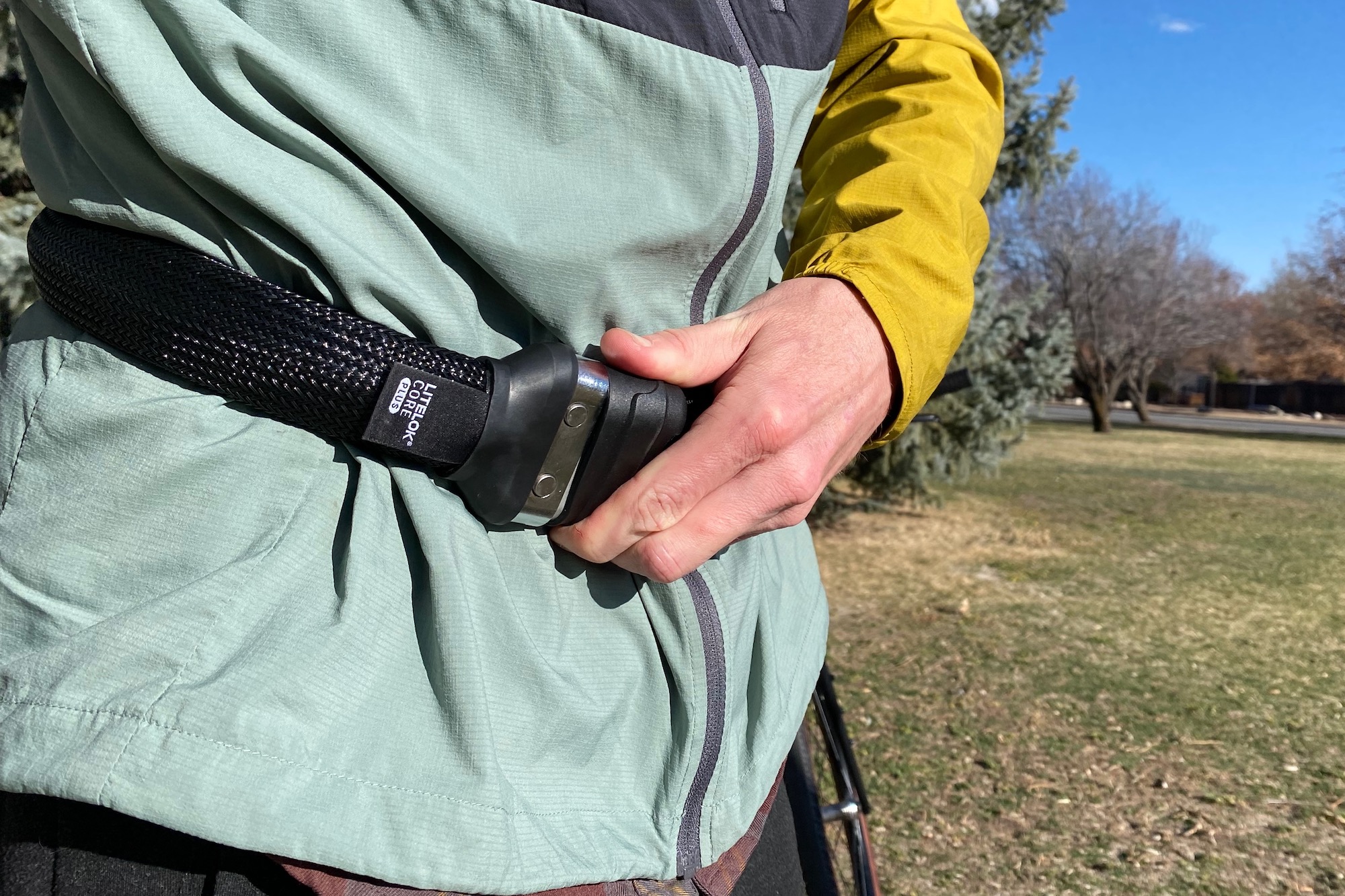
Other Bike Locks To Secure Your Ride
- MSRP: $160
- Type: Chain
- Sold Secure rating: Gold
- Mfg. Security rating: Highest
- Materials: Hardened steel with fabric cover
- Weight: 2315 grams (5.1 lbs)
- Dimensions: 85cm locking perimeter, 10mm chain gauge, 12mm shackle diameter
Pros
- Fairly comfortable to carry on waist for short distances
- Great key feel
- Lighter weight than other chain locks
- Much more easily portable than other chain locks
Cons
- Waist carry is not super comfortable for long distances
- 30-44” waist sizing will limit some smaller or larger customers
- No LED key (though three provided)
- “Belt” end can get in the way when locking up, a little bit finicky but not a deal breaker
- 85cm length is on the short side
- MSRP: $35
- Type: Cable
- Sold Secure Rating: Not rated
- Mfg. Security rating: Light/Low
- Materials: Solid steel core and flexible cable
- Weight: 80 grams (0.17 lbs)
- Dimensions: 45cm locking length
Pros
- Lightweight and easy to carry
- A lock is always better than no lock and this type of lock can discourage purely opportunistic, unprepared thieves
- Also good for locking things other than bikes
Cons
- Low security – only to deter the most opportunistic of bike thieves
- Cut fairly easily with hand shears – only lock in the test
- Only 3 digits in combination – relatively quick and easy to run through all possibilities
- MSRP: $200
- Type: Folding
- Sold Secure rating: Gold
- Mfg. Security Rating: 15/15
- Materials: Hardened steel bars with integrated rivets
- Weight: Lock: 1767 grams (3.9 lbs), Frame mount: 147 grams
- Dimensions: 90cm locking perimeter
Pros
- Easily mounts to bottle cage braze ons or included frame mount
- Rounded rivet faces discourage drilling
- Easy to carry mounted to bike or in bag
Cons
- Heaviest folding lock
- Slightly more difficult to use than other folding locks tested – not a clean feel pushing in
- MSRP: $107
- Type: U-Lock with Cable
- Sold Secure Rating: U-Lock: Gold, Cable: not rated
- Mfg. Security Rating: 7/10
- Materials: Hardened Steel, braided steel cable with epoxy coating
- Weight: U-Lock: 1117 grams (2.5 lbs), Cable: 332 grams (0.75 lbs), Frame mount: 103 grams
- Dimensions: 8.4cm x 17.8cm U-lock locking area, 122cm (4-foot) cable
Pros
- Value – cable included with a U-lock for $107
- Reasonable level of protection and good value for low risk areas/usage
- $2500 Anti-Theft Protection Offer (U-lock only)
Cons
- Cable will not be enough security in high risk areas
- Small U-lock locking area makes it difficult to get the most security possible out of this package
- Frame mount is large and will limit water bottle room on most frames, even with the relatively small U-lock
- Not the most stable frame mount, fabric mount moved around a bit on us
- MSRP: $160
- Type: U-Lock
- Sold Secure rating: Diamond
- Mfg. Security Rating: 15/15
- Materials: Hardened Steel
- Weight: Lock: 1465 grams (3.2 lbs), Frame mount: 156 grams
- Dimensions: 10.8cm x 23cm locking area
Pros
- Diamond Sold Secure ranking
- Pointed end is easy to loop around smaller fixtures
Cons
- Only two keys provided
- Frame mount takes up lots of space, pivoting mechanism is not sleek
- Pointed end limits locking to larger fixtures
- Despite the Sold Secure Diamond rating, it was the second quickest U-lock we tested to cut
- MSRP: $90
- Type: Chain
- Sold Secure Rating: Not rated
- Mfg. Security Rating: 7/15
- Materials: 6mm chain with 8mm steel coil surrounded by robust webbing
- Weight: 1133 grams (2.5 lbs)
- Dimensions: 85cm locking perimeter
Pros
- Quiet, well padded webbing cover
- Key automatically pops to closed position when lock is closed, eliminating risk of forgetting to actually lock
- Reasonably lightweight
- Can be figured-eighted to a reasonable carrying size
- Very easy to route through frame and use
- Required different tools to cut webbing cover and chain/coiled cable
Cons
- Shorter locking length at 85cm
- Not long enough to put over the shoulder or around the waist, not short enough to carry easily, moves around when looped around frame
- Able to break with hand tools only
- Not Sold Secure rated
Bike Locks Comparison Chart
| Lock Model | MSRP | Type | Sold Secure Rating | Mfg. Security Rating | Weight |
|---|---|---|---|---|---|
| Litelok X1 | $200 | U-lock | Diamond | Highest | Lock: 1,711 grams |
| OnGuard Brute 8001 STD | $90 | U-lock | Diamond | 95/100 | Lock: 1,643 grams |
| Seatylock Foldylock Forever | $135 | Folding | Gold | 18/18 | Lock: 1,632 grams |
| Kryptonite KryptoLok 610 S | $143 | Folding | Not rated | 6/10 | Lock: 1,160 grams |
| OnGuard Mastiff 8019L | $130 | Chain | Gold | 90/100 | 4,876 grams |
| Kryptonite Fahgettaboudit 1410 | $210 | Chain | Diamond | 10/10 | 5,034 grams |
| LITELOK CORE Plus | $180 | Wearable | Diamond | High Security | 1,860 grams |
| Hiplok Gold Wearable Chain | $150 – 160 | Chain | Gold | Highest | 2,315 grams |
| ABUS Combiflex Travelguard | $35 | Cable | Not rated | Light/Low | 80 grams |
| ABUS Bordo Granit 6500K | $200 | Folding | Gold | 15/15 | Lock: 1,767 grams |
| Kryptonite Mini-7 with 4′ Cable | $107 | U-lock with cable | U-lock: Gold | 7/10 | U-lock: 1,117g, Cable: 332g |
| ABUS Granit XPlus 540 + SH B | $160 | U-lock | Diamond | 15/15 | Lock: 1,465 grams |
| ABUS Goose 6206K | $90 | Chain | Not rated | 7/15 | 1,133 grams |
Why You Should Trust Us
At Bikerumor, we are passionate about bikes, and keeping them safe and secure is of utmost importance to us. Some of us have even had expensive bikes stolen and know firsthand the pain, disappointment, and monetary loss that bike theft can cause. We always lock our bikes when they are anywhere other than inside our homes, and we’re always searching for the best locks to keep our precious rides safe.
For our bike lock buyer’s guide, we called on Bikerumor contributor and review author Paul Clauss to test and compare 13 of the best models on the market side by side. A mechanical engineer by trade, Paul has a keen eye for design and features that enhance ease of use and functionality. He enjoys tinkering with products to tease out their strengths and weaknesses, and he is particularly adept at identifying their flaws when asked. In addition to using each lock as it was intended, Paul ran each through a series of destructive tests to see how they stand up to the most common methods of bike theft. After testing was completed, we narrowed down our favorite models, considering factors like portability, ease of use, functionality, and security based on our findings.
An avid mountain biker and mountain bike coach, Paul has also applied his passion for testing and analyzing products to several other buyer’s guides. He has also tested and reviewed dropper seatposts, the best flat pedals on the market, as well as flat pedal shoes to go along with them.
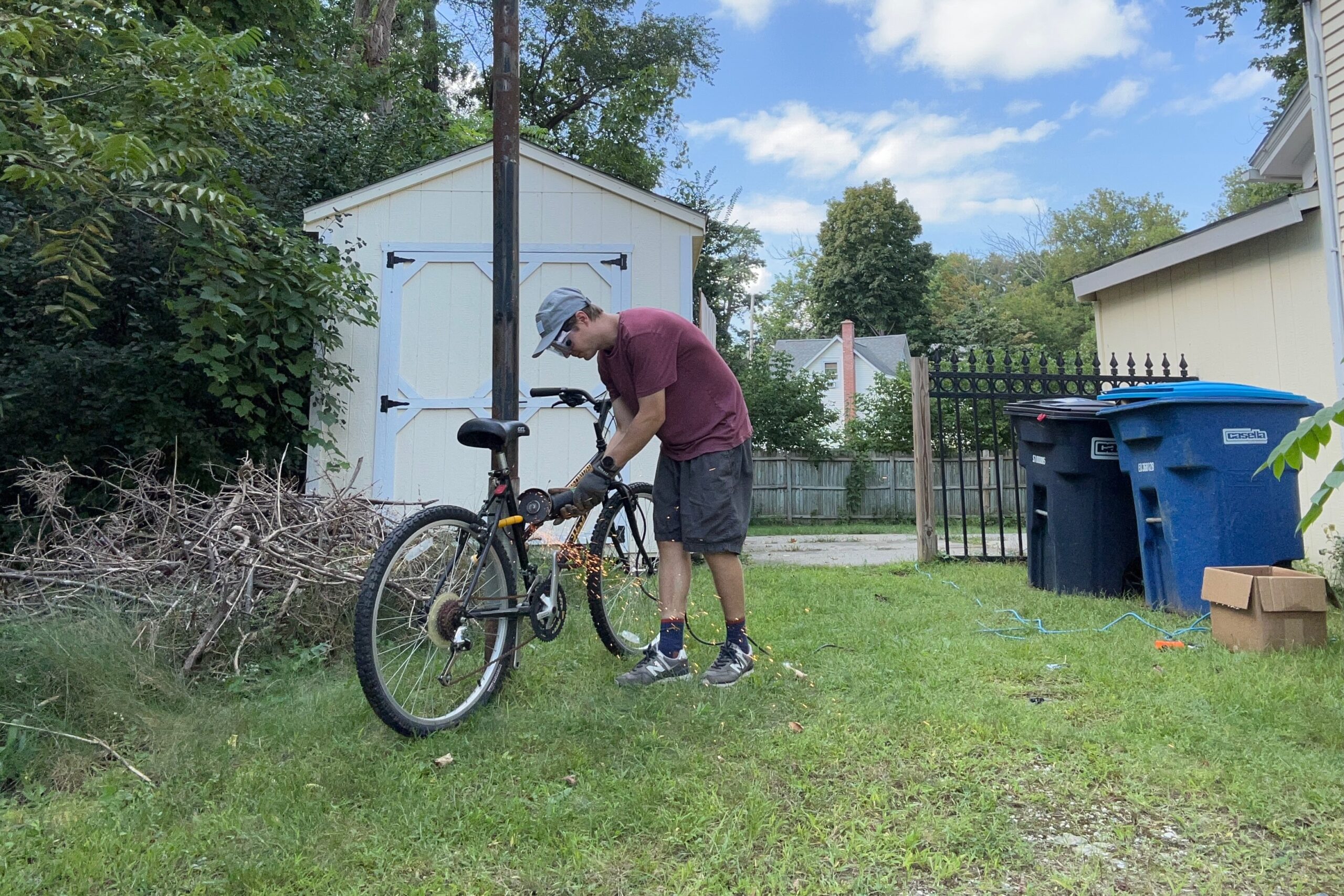
How We Tested Bike Locks
Over the course of several weeks, we tested each model in the field to assess its performance in terms of portability, ease of use, and overall functionality. We locked bikes to bike racks, benches, poles, and fences, locking and unlocking them numerous times to get a feel for the locking mechanisms and attachment methods. When applicable, we utilized the included frame mounts to assess their effectiveness, the security with which they hold the lock, and their versatility in terms of mounting and bike fit. After that, we subjected each model to a series of cutting tests using the most common methods of modern bike thieves to see for ourselves how much effort it takes to compromise them.
Each lock we tested was subjected to the following abuse, in this order:
- Attack with small, hand-held tin snips/shears.
- Attack with larger, 24” bolt cutters.
- Attack with an angle grinder using a metal cut-off wheel. This was done with the lock in use.
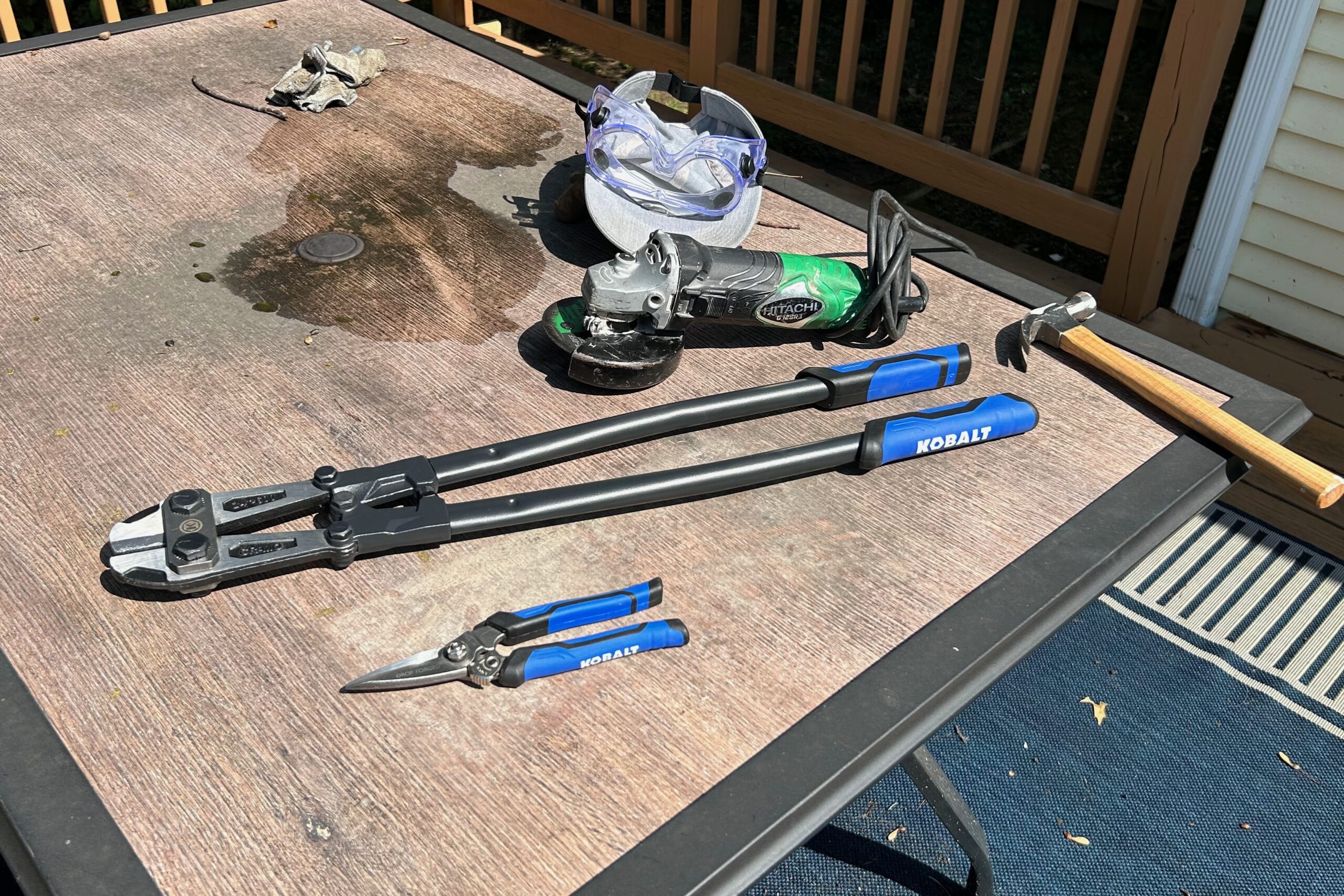
There are certainly many other ways to break bike locks, but these are three of the most common methods. While it is possible some of the locks that resisted bolt cutters could be snipped with larger, 36” bolt cutters, 24” is a common size available at most hardware stores for an affordable price. And, for the locks we were able to cut with the bolt cutters, all (including the Kryptonite cables) required quite a bit of effort and were not easily defeated. While an angle grinder is capable of breaking pretty much any lock given enough time, we were pleasantly surprised across the board by the resistance to bolt cutters, especially from the U-locks and folding options.
In addition to the cutting test, we briefly attempted to drill out the rivets on the folding locks. However, using basic drill bits rated for metal/wood/plastics and a cordless drill, we hardly damaged the pivots and couldn’t create a clean hole in any of them. Prying and applying leverage to the folding locks also proved to be futile, with each model holding full body weight while bouncing up and down without bending. While there are likely ways to break folding locks by drilling or by using leverage, it seems it would take significantly longer than the angle grinder, which was relatively quick to cut all the folding locks (and they only require one cut).
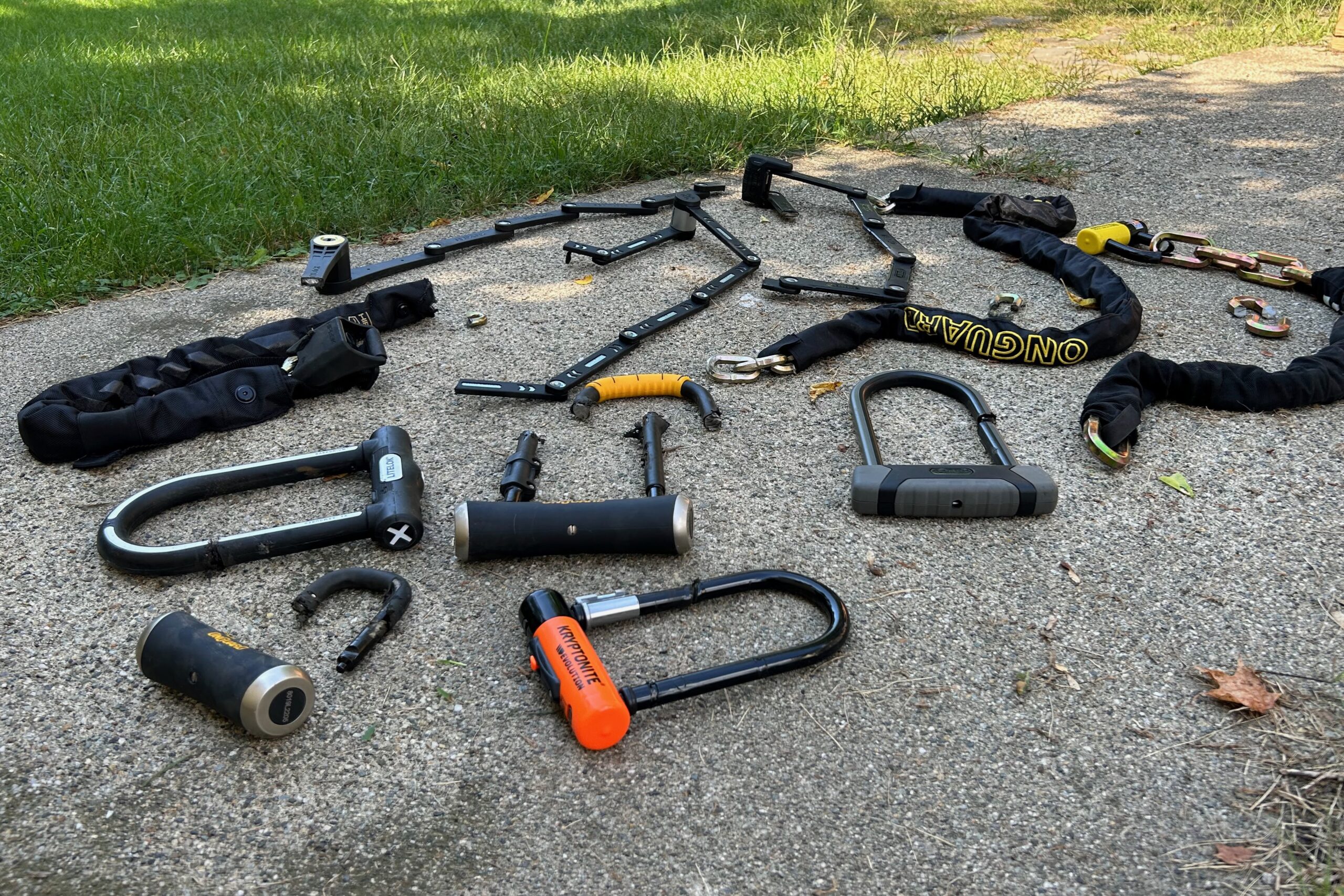
Buying Advice: How to Choose a Bike Lock
The bike lock market is ever-changing with new models, materials, and designs promising higher levels of security than ever before. With so many options to choose from, finding the right bike lock for your needs, budget, and desired level of security can be a challenging task. We wrote this buying advice article to help clarify any confusion and guide you through your bike lock purchase decision.
Types of Bike Locks
The major categories of bicycle locks on the market are as follows: U-locks (or D-locks), Chains, Folding Locks, and Cable Locks. A description of each type, and its advantages and disadvantages, is included below:
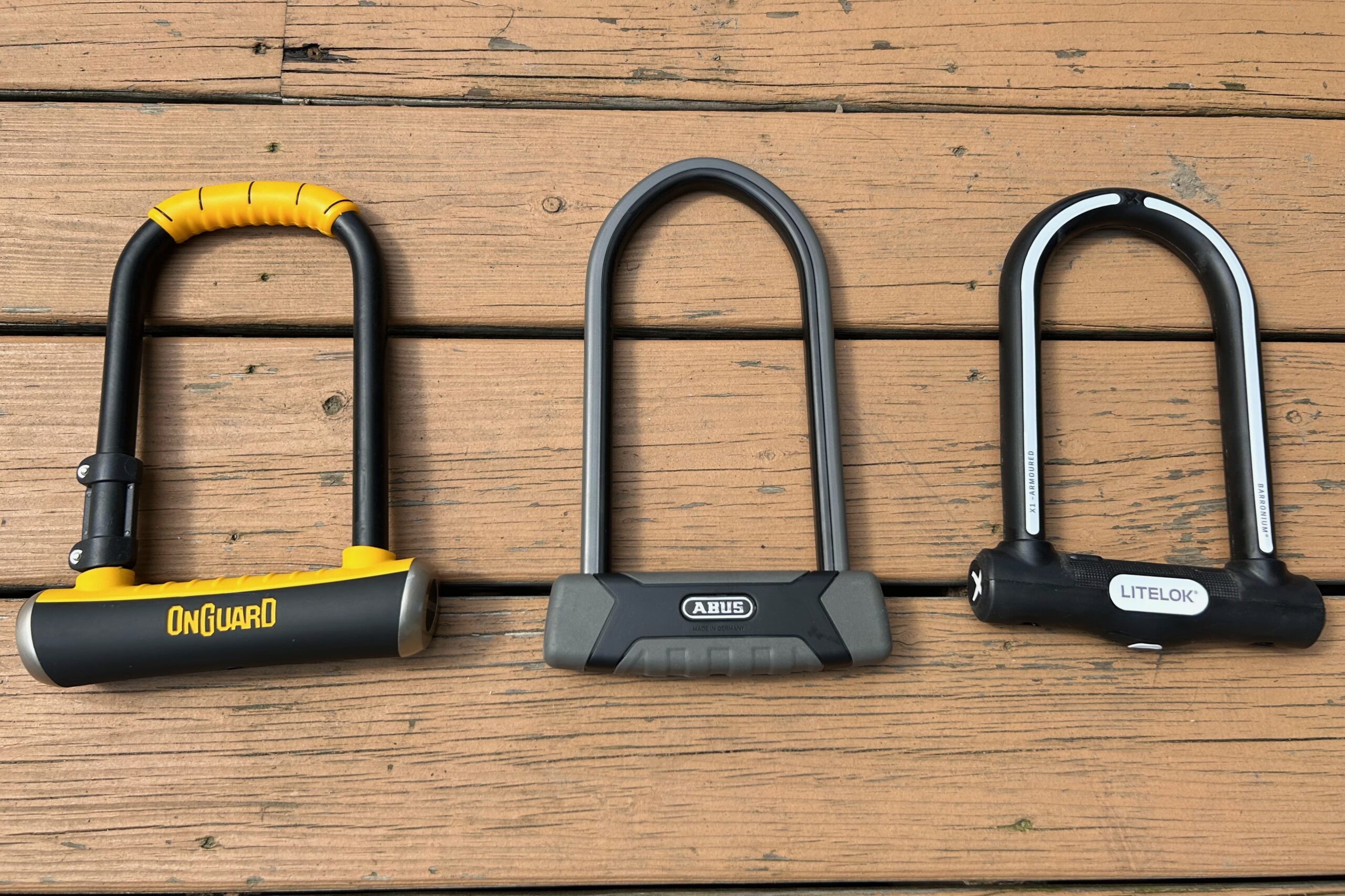
U-Locks (or D-Locks)
U-locks are generally regarded as the highest security locks available. Consisting of a high-strength shackle (the “U”) and crossbar (making the “U” into a “D”), U-locks are a relatively compact option that cyclists can loop through the bike frame and a wheel when locking to a bike rack, pole, or similar object, though they can be tricky to use when locking to structures with larger cross sections. U-locks fit tightly to the frame when in use, making it difficult for thieves to cut them without damaging the frame. Although U-locks can be compromised by a dedicated bike thief using power tools (or possibly large bolt cutters) on less secure or smaller U-locks, a high-quality, high-security-rated U-lock should deter most less committed criminals.
While high-security U-locks can be heavy, many U-locks come with a spline on the shackle that mates with an included frame mount, making portability easier for commuter cyclists. Their relatively small footprint usually does not allow you to secure both wheels and the frame, but U-locks are often used in conjunction with chain and cable locks to increase the locking length. Three of the U-locks we tested, the Litelok X1, OnGuard Brute 8001 STD, and the ABUS Granit XPlus 540, have the highest level Diamond Sold Secure rating.
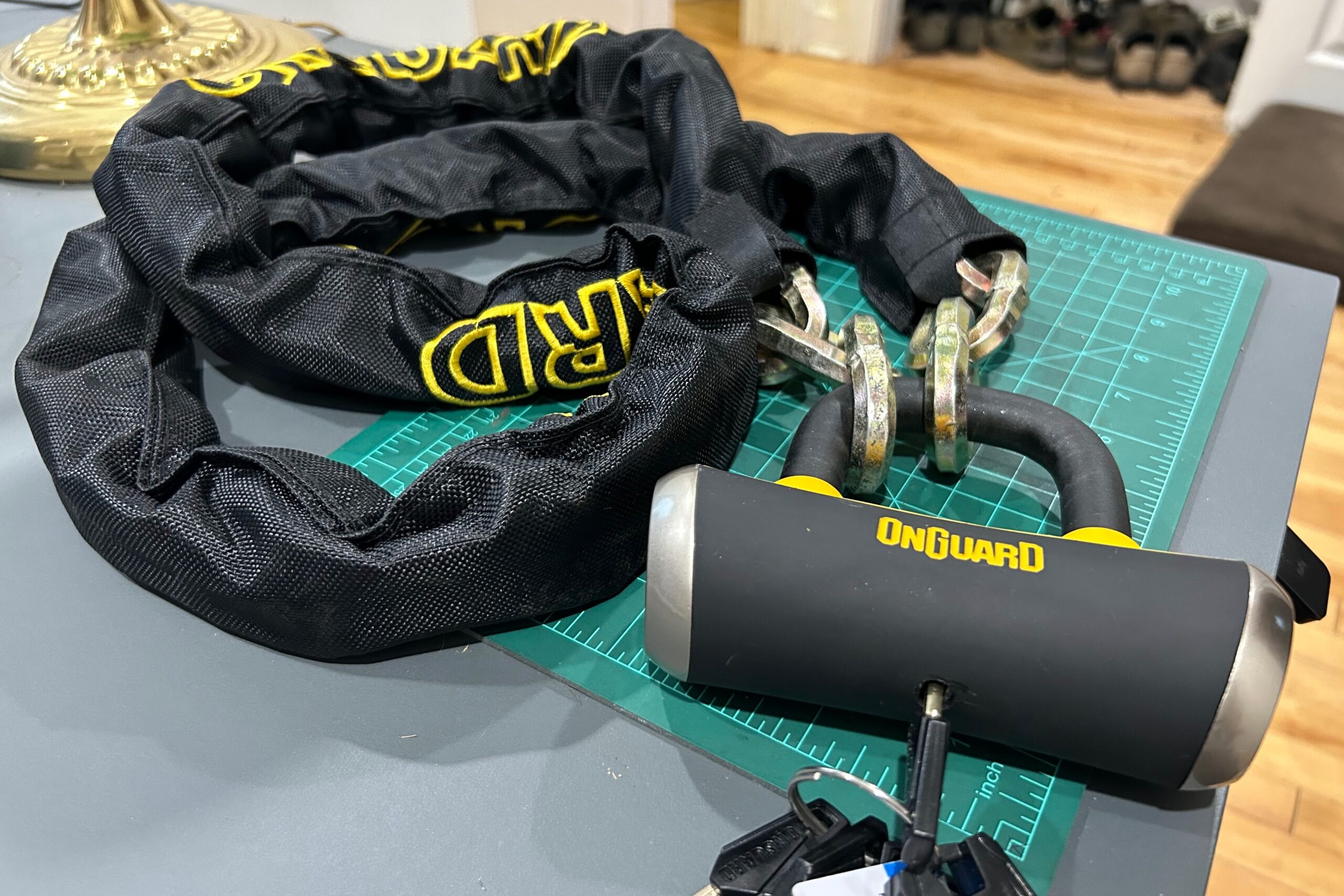
Chain Locks
Chain locks are exactly what they sound like – a thick, generally hardened steel chain locked end to end. Most of the chain locks we tested use a small U-lock, like the Kryptonite New York Fahgettaboudit 1410, although some, like the Abus Goose or HipLok Gold, use alternative, attached connection methods. The chain is only as secure as the locking mechanism, so it is important to consider this when selecting a chain lock. The chains themselves have a wide range of cross-sectional thickness, and, because chains can be broken by applying torsional force, it is important to look for chain locks with small gaps. Like U-locks, even the largest and thickest chain locks can be compromised with a cordless angle grinder. Most chain locks come with fabric sheathing to avoid scratching your bike.
Chain locks are also available in a wide range of lengths and link sizes. A long chain, like the OnGuard Mastiff 8019L, is great for locking to large obstacles, circling multiple bikes, and using with bike racks on cars. They are also quite heavy and unwieldy, making them a great choice for locking in your garage or keeping in the car, but a poor choice for commuting with the lock.
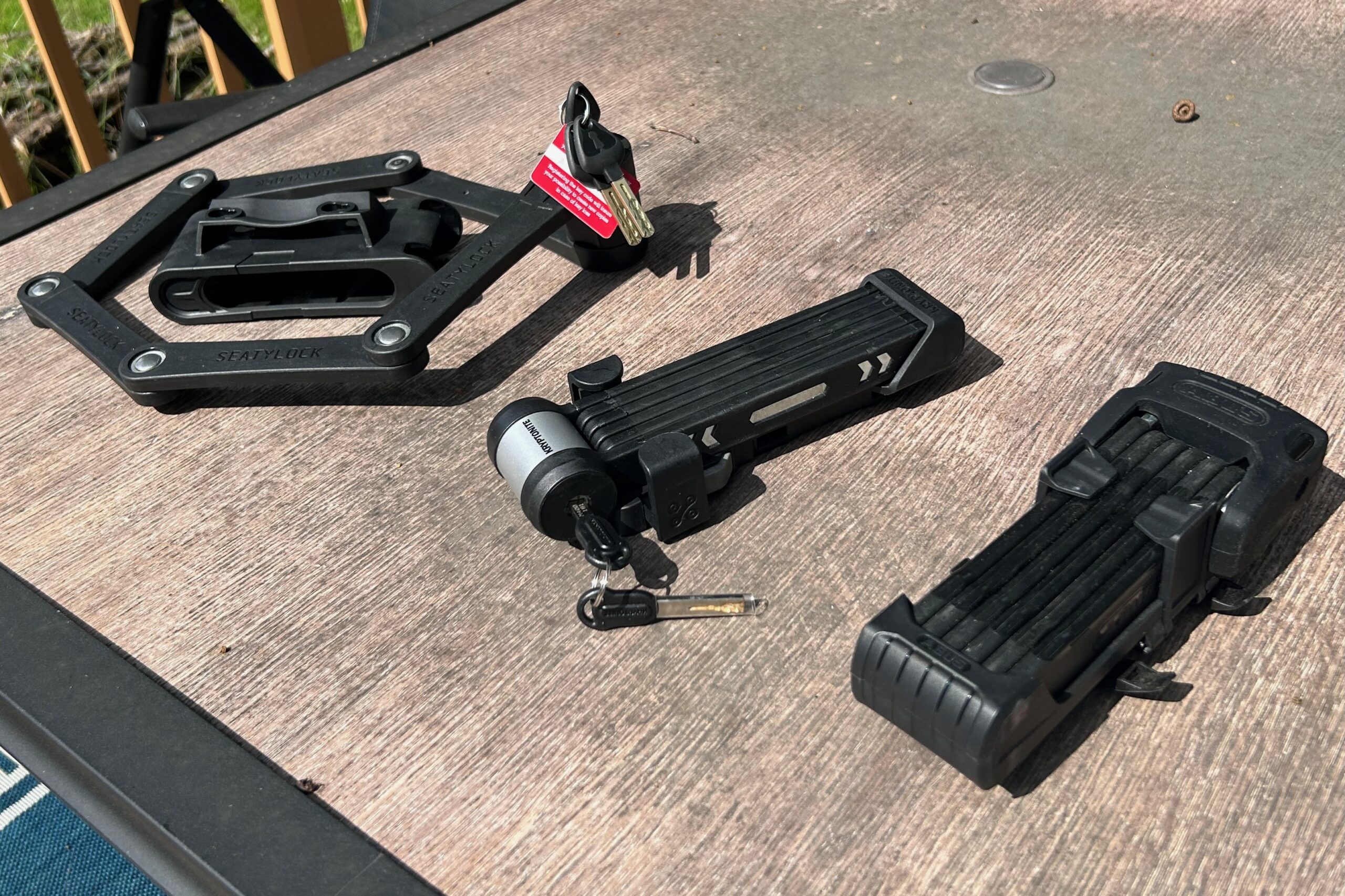
Folding Locks
Folding locks consist of pivoting bars that lock together at the ends, which can be folded into a compact package when not in use and extended to provide more flexibility than U-locks with respect to what can be locked to. With moderate weights and small collapsed dimensions, folding locks can be mounted to frames or carried in bags fairly easily. While they are easy to transport, the pivoting joints present a weak point in the design, and folding locks are generally considered less secure than many U-locks or chains, but many, like the Seatylock Foldylock Forever and ABUS Bordo Granit 6500K, do meet the Gold-level Sold Secure standards, making them a good option for commuters in low to medium-risk areas.
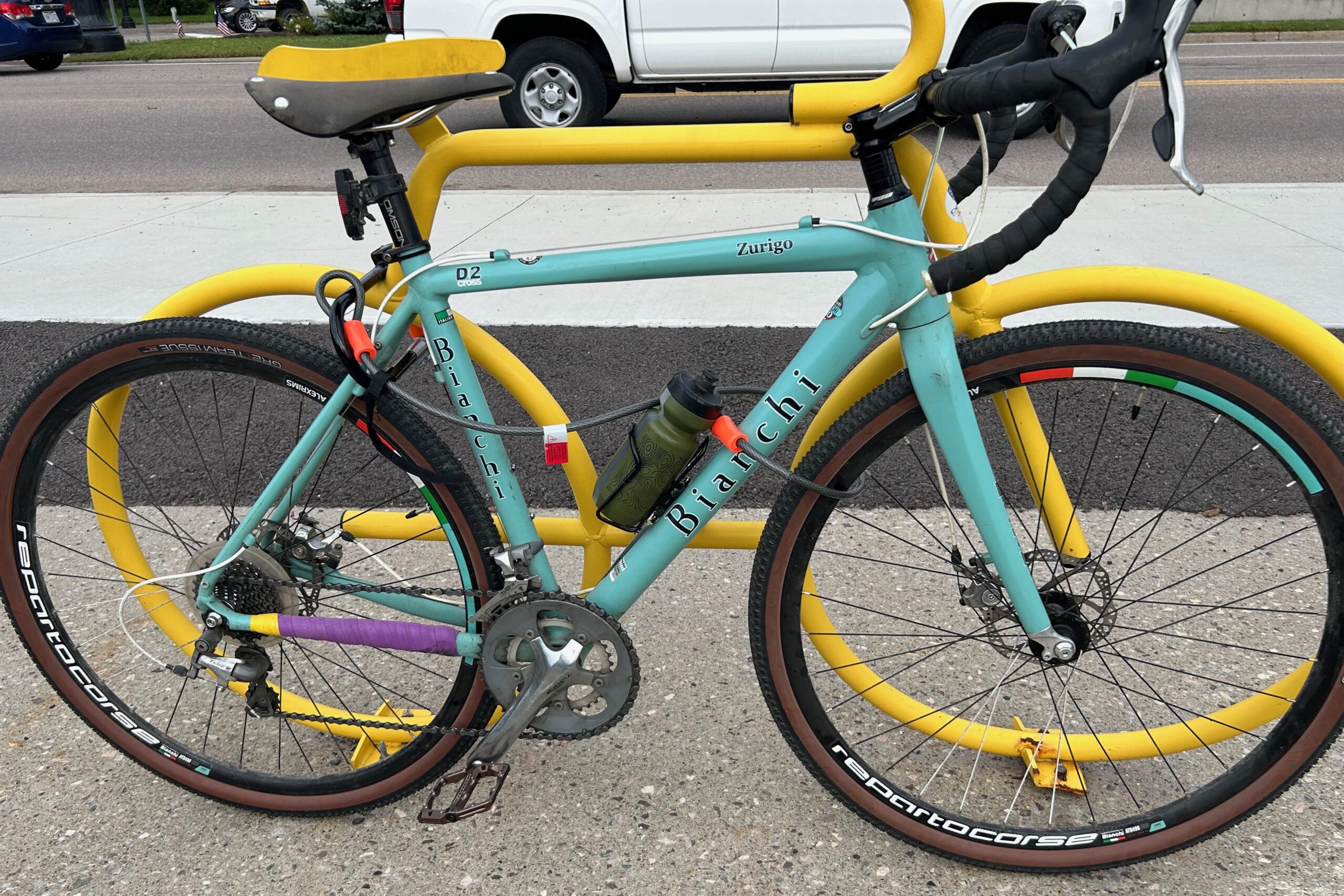
Cable Locks
Cable locks are inexpensive, widely available, lightweight, easy to use and carry, and available in nearly any length. They can be secured with a combination key, padlock, U-lock, or nearly any other locking mechanism you can imagine (or buy at the hardware store). Cable locks are also the least secure lock option, as smaller, flexible cables can be easily cut with hand tools, and larger cables require only a larger pair of bolt cutters or less than 15 seconds with a Dremel tool or cordless angle grinder.
While we don’t recommend relying solely on cables to secure your bike, we do suggest using them in addition to other locks, particularly with U-locks, as a secondary means to secure your front wheel. Using a cable lock is unlikely to deter a thief with a high level of commitment, but it is easy to carry and beats leaving your bike unlocked for quick stops in relatively safe locations.
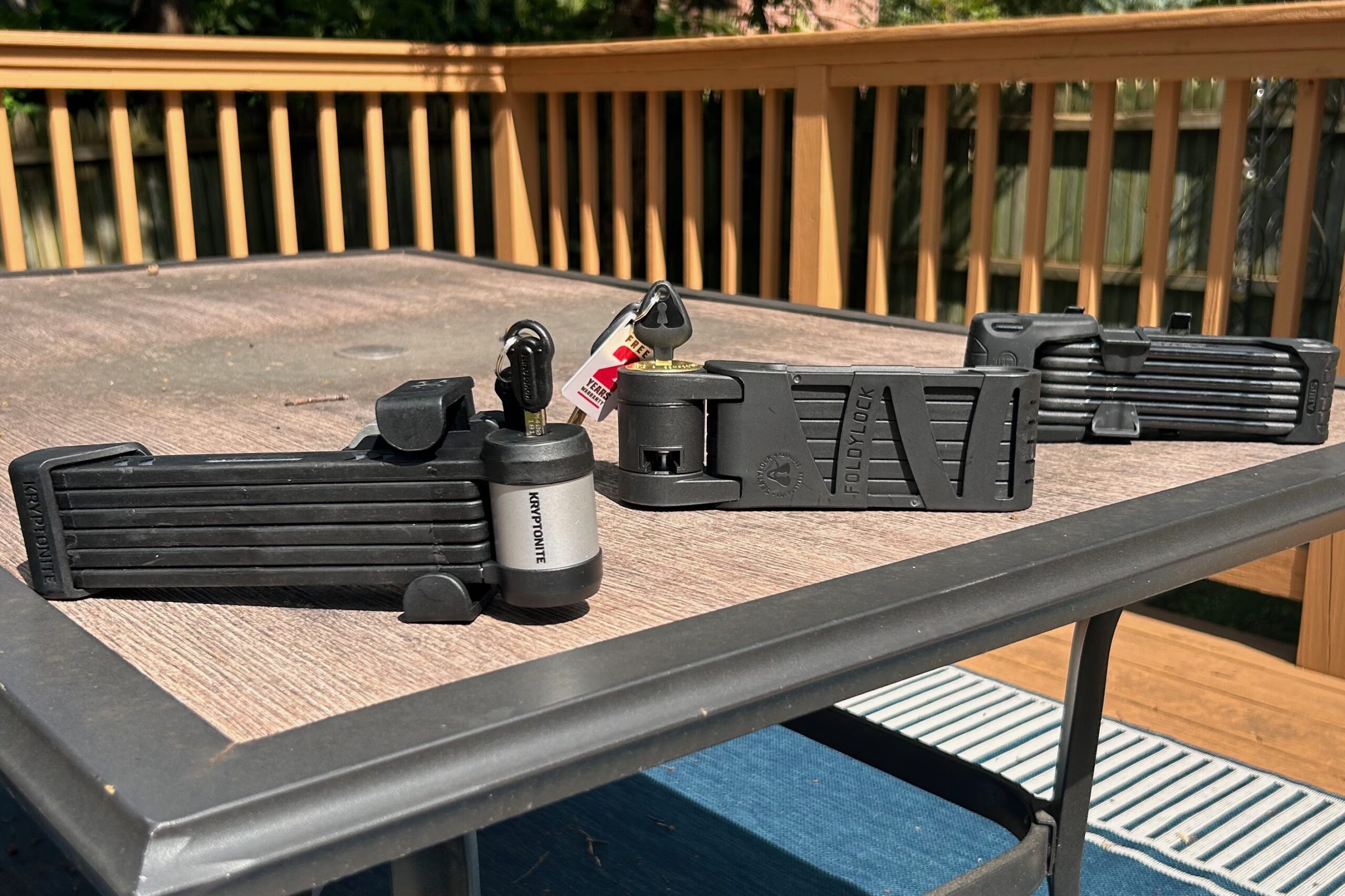
Locking Mechanisms
Just as there are different styles of locks, there are also various locking mechanisms that accompany them. The two most common types of lock mechanisms are key locks and combination locks.
Combination Locks
Combination locks use a numerical, alphabetical, or symbolic key that is arranged in a specific sequence to open each cylinder of the locking mechanism. While you don’t have to keep track of a key, combination locks could be attempted by anyone who walks by and are generally less secure in their construction than keyed locks. For a lightweight cable lock used in addition to a more secure chain, cable, or folding lock, or a low-security lock used only for quick stops in low-risk areas, a combination lock might deter uncommitted bike thieves. However, we recommend keyed locks for most applications.
Key Locks
Keyed locks require a specific key to open and close the lock. The locks tested came with between 2 and 5 copies of the key. If you have a small number of spares, label them and store them in a safe location so you don’t have to figure out how to break the locks yourself. The majority of the locks we tested were keyed locks, and we appreciated those that included keys with LED flashlights, making it easy to find the keyhole in the dark.
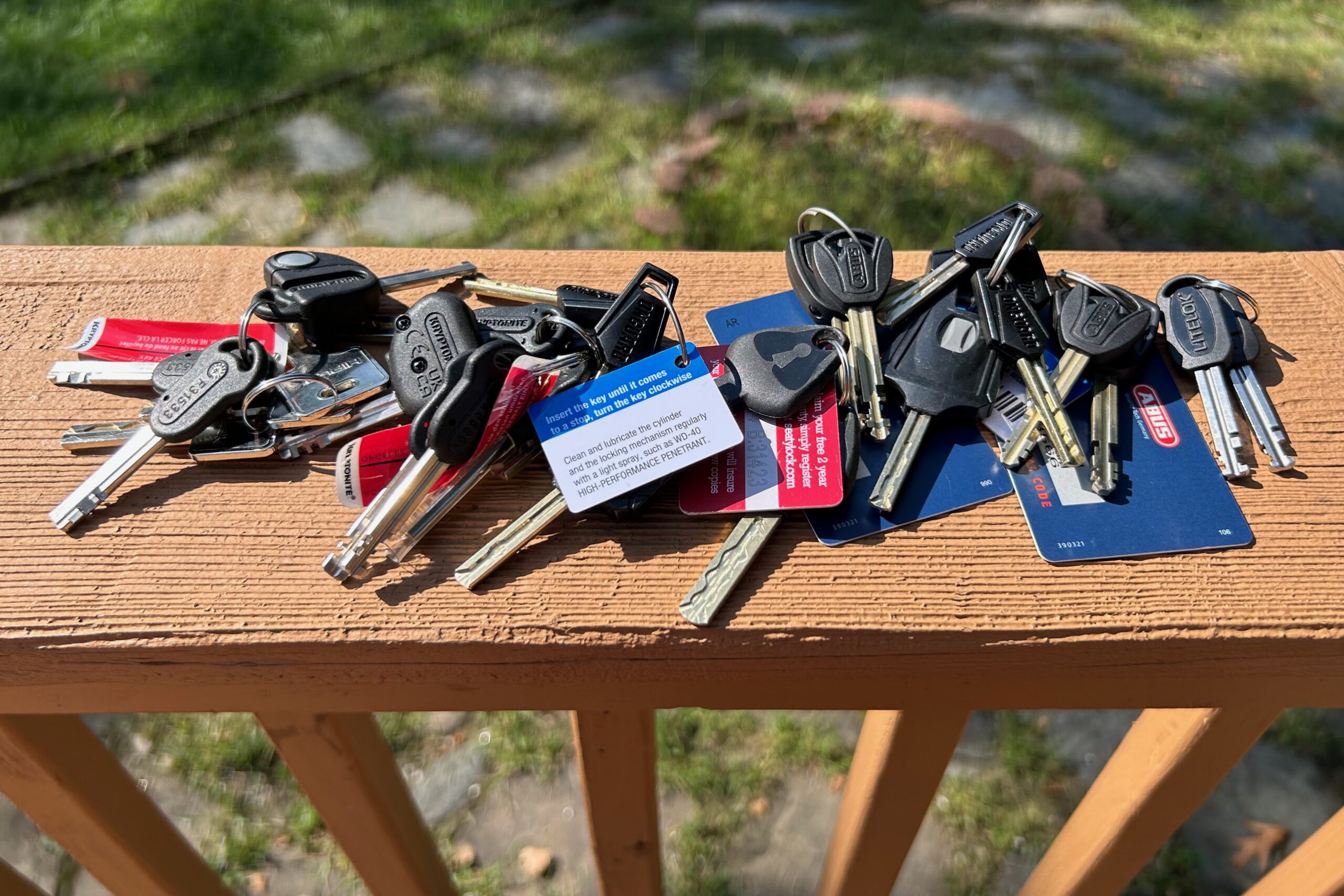
Other Factors To Consider
When considering which bike lock is best for you, we recommend considering the level of security, portability/weight, ease of use, and sizing as major variables.
Level of Security
The level of security you should look for in a bike lock depends on where and when you lock up. In general, choose the most secure lock that you can afford to purchase and carry. If you live near a college campus, in a major city, or in any area with high crime or bike theft rates, you should certainly invest in a high-quality U-lock, chain lock, or both. If you are a commuter who consistently carries your lock on your person or mounts it to the frame, a folding lock might provide a good balance of security and portability. As we found in testing, all of these locks can be compromised given enough time and the right tools, even those with a Diamond-level Sold Secure rating, but 4 minutes with an angle grinder is tougher for thieves to get away with than 10 seconds to snip a small cable lock.
If you live in a safe, more rural area, we still recommend having a solid chain and U-lock to use for quick stops when the bike is on the car rack. Consider the price of your bike and buy a lock with a comparable level of security – you never know who will be driving through that day, and it’s easy to take a bike off a rack, throw it in the back of a truck, and drive away in less than 30 seconds. When considering the level of security provided by a lock, read reviews and use common sense, taking into account the size of the lock and your specific security needs. While you shouldn’t rely on cables as your primary locking means, it never hurts to have a few in different sizes to complement your main lock.
Most manufacturers have their own security rating scale to denote the level of security offered by their locks. These rating scales vary, however, so it isn’t an apples-to-apples comparison between brands. For example, Kryptonite uses a 1 to 10 scale, while Seatylock’s scale goes to 18. That’s why we appreciate the Sold Secure ratings, which are based on actual destructive testing.
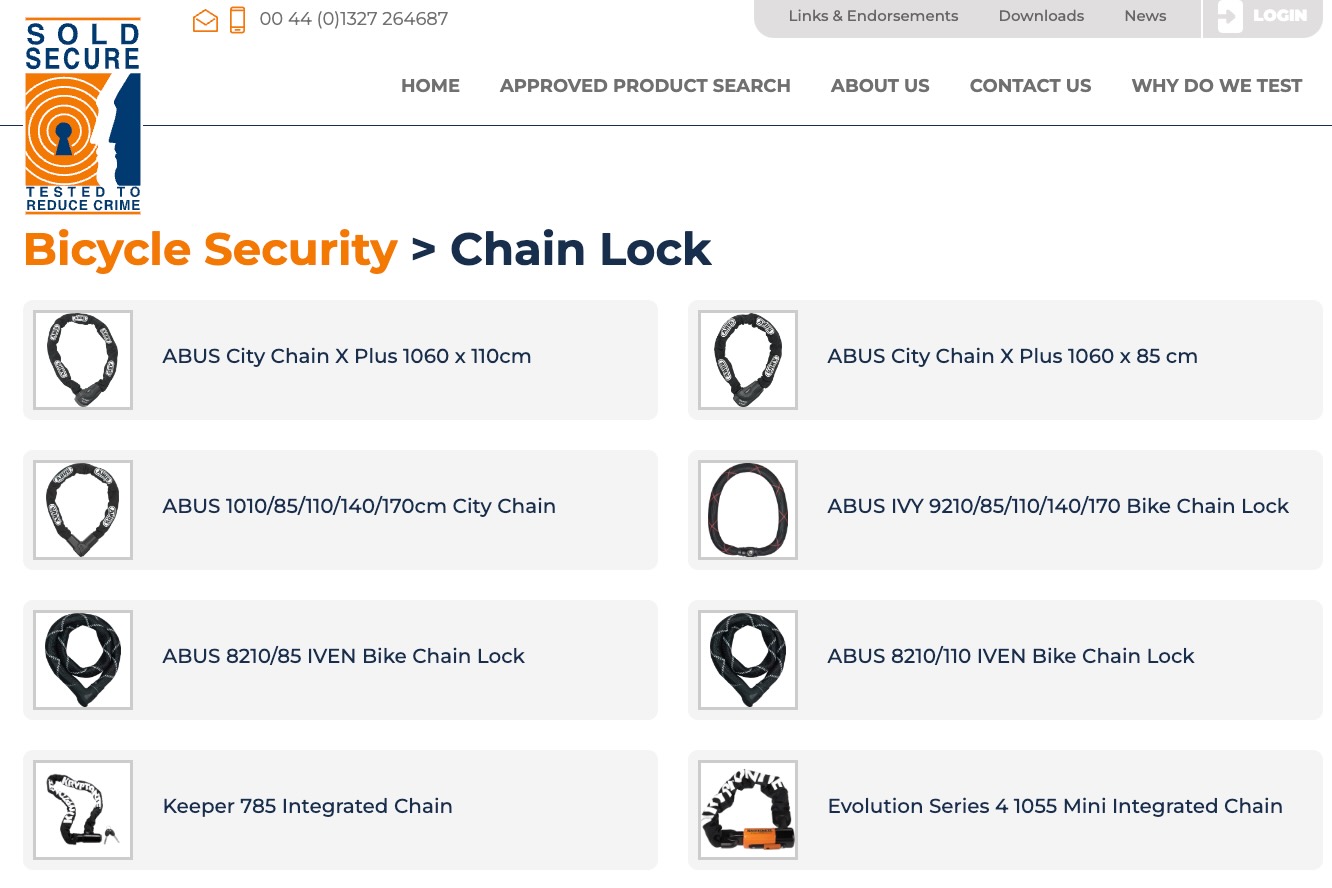
Sold Secure Ratings
Sold Secure is an organization dedicated to reducing the risk of crime by the assessment of security products. They test a wide variety of security products, from safes to automotive locks to bicycle locks, and rate them on their four-level scale described below:
- Bronze: Offering theft resistance for at least one minute against a basic tool list (aimed at preventing opportunistic crime).
- Silver: Offering theft resistance for at least 3 minutes against an enhanced tool list (aimed at preventing more determined attacks)
- Gold: Offering theft resistance for at least 5 minutes against a dedicated tool list (aimed at preventing dedicated attacks)
- Diamond: The highest level of theft resistance for at least 5 minutes, including 1.5 minutes against an angle-grinder (aimed at preventing the most destructive attacks that could include angle grinders)
Our comparison table includes the Sold Secure rating for the locks they have approved. It is important to note that some insurance companies only cover bike theft if the bike is locked with a Sold Secure-rated lock. Most lock manufacturers also have their own security scales for locks in their catalogs, which can give a relative view of the security of the lock within their range.
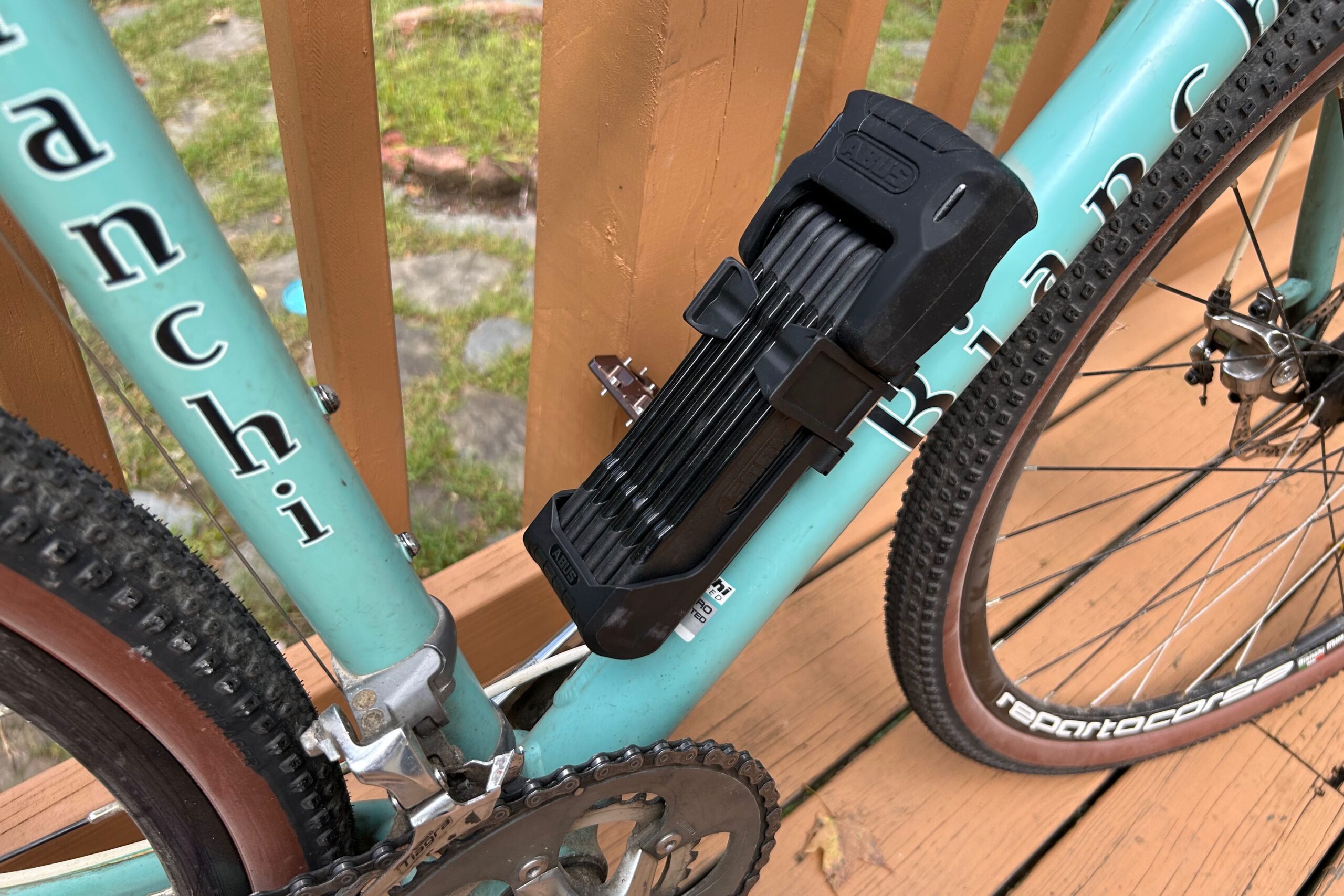
Portability/Weight
Security for your risk level should be your top concern when selecting a bike lock, but you’ll need to balance it against portability/weight if you intend to carry the lock with you. In general, folding locks and U-locks are the most portable, with smaller dimensions and lower weights, and most come with a frame mount of some kind, allowing them to be attached to the bike in transit. Even if you don’t attach them to your bike, they are usually fairly easy and convenient to carry in a bag while you ride. Of the two styles, folding locks are the most portable, as they can be folded down to a compact size when not in use. The Seatylock Foldylock Forever, for example, folds down relatively small and fits nicely into its included frame mount that attaches to bottle cage mounts. Similarly, U-locks, like the Litelok X1, often come with a good frame mount; they just take up a little more space within the front triangle.
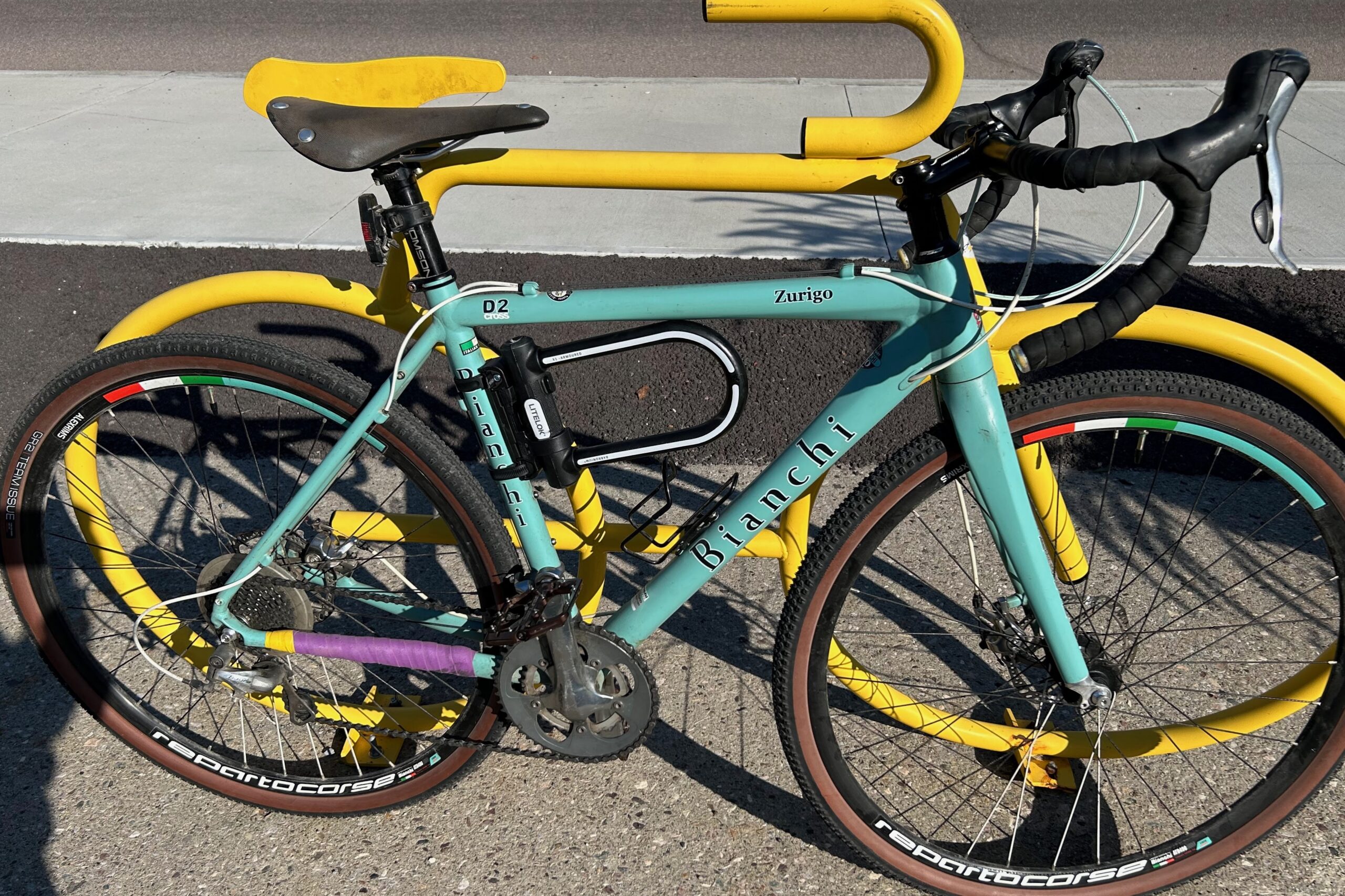
Chain locks, on the other hand, are bulkier, heavier, and more difficult to carry with you. The longest and second heaviest chain lock in the test, the OnGuard 8019L Mastiff, for example, is a good, secure option to keep in the car for locking to the bike rack, but, at over 10 lbs and nearly 6’ long, it is not the best lock to carry on anything but the shortest commutes. The LITELOK CORE Plus and Hiplok Gold are exceptions, as they both have unique designs that allow them to be worn as a belt for transport. Some other shorter chain locks can also be slung over the shoulder for short distances, though their weight and size can be cumbersome and uncomfortable.
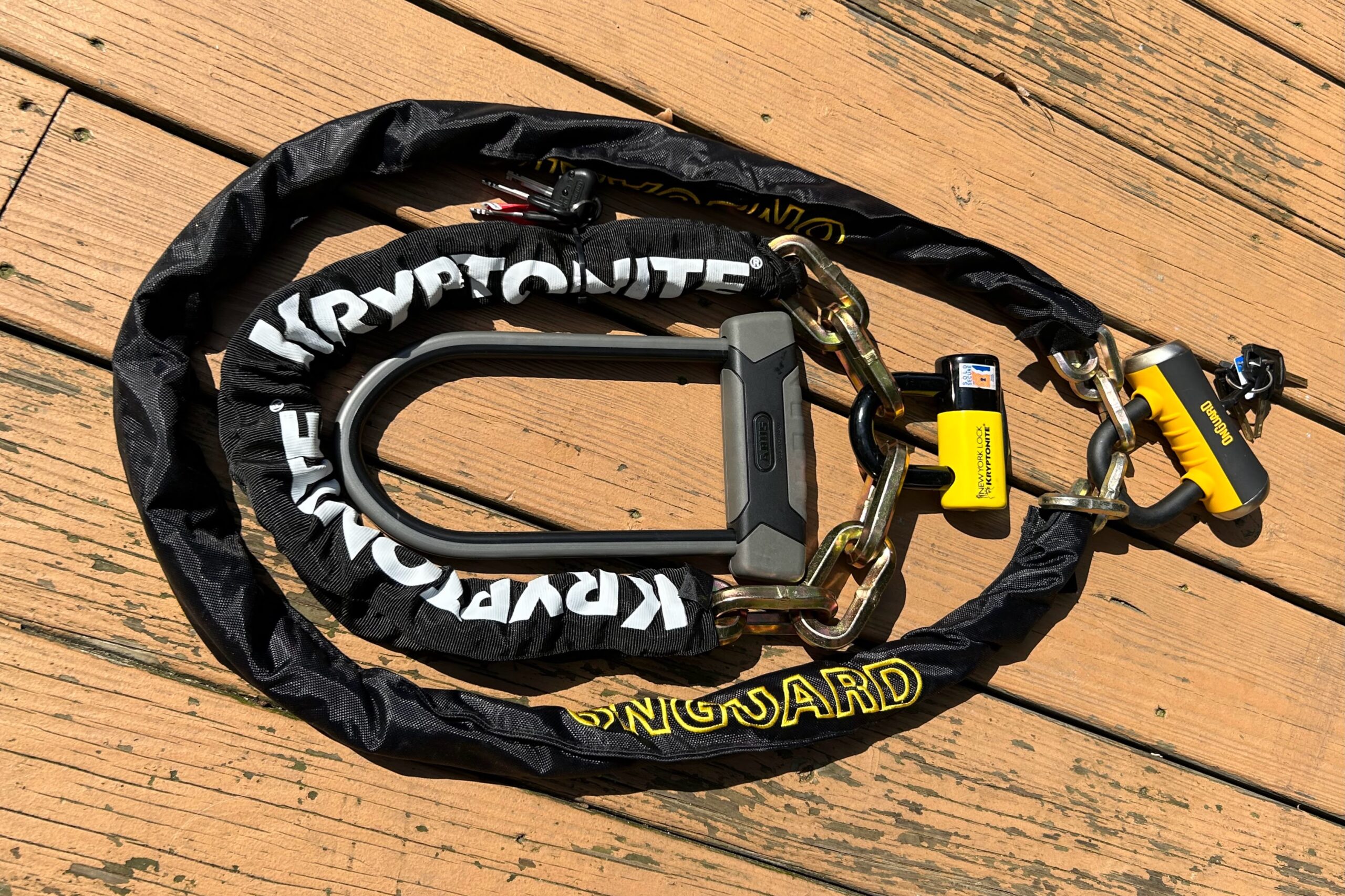
Sizing
Your needs will dictate the size of the bike lock that is best for you. Locks with smaller areas, particularly U-locks, will limit what parts of your bike and what you can lock your bike to, and inflexible designs can make it difficult to route around curves. Folding locks offer a surprisingly large locking area, 90cm to 100cm among the models we tested, and are able to loop through the frame, a wheel, and around a fixed object. Chain and cable locks come in a variety of lengths and are generally very easy to use in a variety of scenarios, but suffer in terms of portability and security (in the case of cable locks). A long length is great for locking multiple bikes at a time or securing to large features or car racks, but difficulty transporting them makes them better suited to leaving in the car or using around the home.
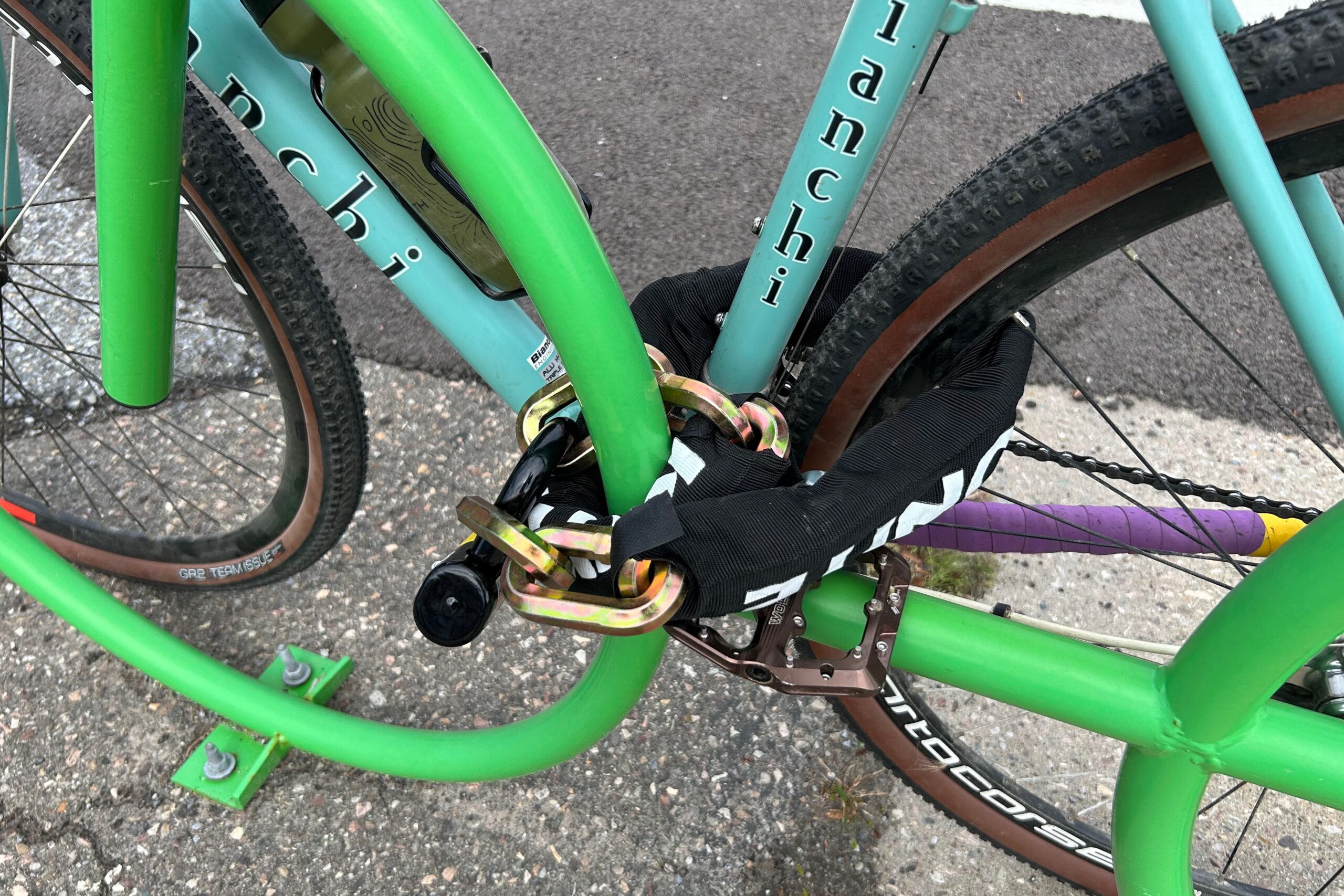
Price
Bike locks aren’t cheap, but they are typically less expensive than replacing a stolen bike. In general, we’ve found a strong correlation between price and security. While not everyone needs the absolute strongest lock on the market, exceeding the level of theft risk is never a bad thing. We always recommend spending as much as you can on a bike lock, because you never know if your bike will be stolen until it’s too late.
The most important thing is to get a lock with a security level that exceeds the risk of theft and withstands the common methods of bike theft in your area. It’s also important to match the lock type with your portability needs and the type of bike rack or other object you’ll be locking your bike onto. Any lock is better than no lock at all, but trust us when we say that spending a little more for a more secure lock is usually worth it.
Our favorite U-lock, the Litelok X1 ($200), is among the most expensive options we tested, featuring a Barronium-armored shackle. However, it still costs a bit less than some of the other angle-grinder-resistant models, which can cost as much as $300. Similarly, the Foldylock Forever ($135) is among the most expensive folding locks on the market, but it’s also arguably the most secure of that style, with a more robust build than similar locks.
Frequently Asked Questions About Bike Locks
Anytime your bike is unattended outside of your own home, your bike should be locked. Even in areas where the risk of theft is low, bicycles are quick, easy, and quiet to steal away and you never know when you’ll encounter an enterprising thief. Even if you store your bikes outside at your home, they should be securely locked, and any bike left on a car rack should be locked. Think about how quick and easy it is to remove a bike from a rack and throw it in the back of a truck or van.
When you lock your bike to something, the lock can only possibly be as secure as what it is locked to. Wooden fences or small trees can easily be broken, and it is preferable to look for purpose built bike racks and tall poles. When locking your bike, you are looking for an immovable anchor point that cannot be broken. Small stop sign poles might look like a good option, but they are easy to remove from the ground or potentially lift a locked bike over, giving thieves the option to take the locked bike and remove the lock at their convenience in a private location.
Locking your bike in a well traveled area, ideally one you can see from where you will be while the bike is unattended, will help deter theft attempts as well. A thief stealing a bike from a dark, empty alley will have more time and options to break a lock than one on a crowded street.
First, make sure you can prove ownership of your bike before it is stolen. Keep receipts for your bike and major upgrades, make notes and photograph serial numbers, register your bike with Bike Index or Project 529 (also in your city or college campus organization), and take photos of your bike regularly. This evidence will be important when you need to prove ownership of your stolen property when reporting a bike theft.
If your bike is stolen, first file a police report. While stolen bikes are difficult to recover, it does happen. Next, report the theft to your renters, home, or bike insurance. If your bike was stolen in a secured location (like some parking garages) or your workplace, find out if they have any policies covering stolen property and report the incident to them as well.
While it is not guaranteed to work, you may also consider reporting the theft to local bike shops, pawn shops, and local riding groups. I’ve seen stolen bikes returned home through strong riding communities, so make the post on the local riders’ social media pages.
Consider technology as well – an Apple Airtag could help you track down your bike anywhere, and there are companies that make mounts to attach Airpods inside seat tubes, head tubes, or bottle cage mounts so they cannot be seen and easily removed. If you use this technique, be sure to work with local police when retrieving the bike for safety.
There are many ways bike thieves can break even the most secure locks. Any lock can be picked, but most bike thieves opt for a less subtle, brute force technique. This includes using long poles for leverage, hand tools like tin snips and bolt cutters to cut small to medium locks, and power tools like Dremels and cordless angle grinders to quickly remove high-security locks. Some thieves may be able to pick locks and we are certain from the Lock Picking Lawyers YouTube videos that all the locks can likely be picked by an expert, but brute force attacks are much more common.
For the locks in this test, we used a progression of small, inexpensive hand tools up to cordless power tools to see how quickly they could be broken. Starting with a small set of hand shears, moving on to a larger set of 24” bolt cutters, then going to an angle grinder with a 4.5” metal cut-off wheel, which was able to get through all the locks. Some locks like the OnGuard Brute 8001 STD and Litelok X1 Armoured Barronium wore the cutting wheels out very quickly, the latter taking more than two wheels to make the two cuts required to open the lock.
Bike theft occurs everywhere, but there are certainly places where it runs more rampant than others. You can see the signs in high theft areas – bikes missing wheels and seatposts, use of heavy-duty locks, and no expensive bikes to be seen locked up on the streets. This is prevalent in high-risk areas like major metropolitan areas and college campuses. In places such as these, using the strongest and most secure locks available will be the best deterrent short of storing your bike inside if possible.
While bike theft might be less common in smaller communities and rural areas, there are opportunistic thieves everywhere and security should be the top concern when purchasing a lock. Even in quiet and “safe” mountain towns, bike thefts still occur, albeit at a lower rate. Regardless of your location, securing your bike with a trustworthy lock is the best way to mitigate bike theft.
